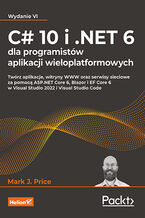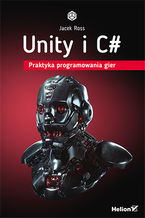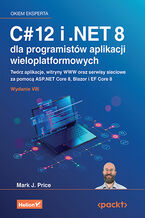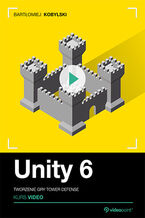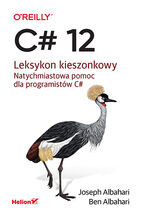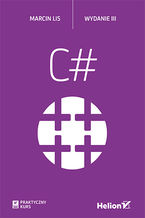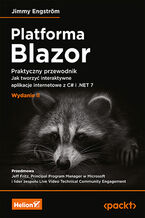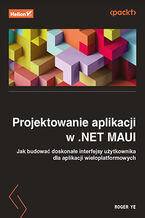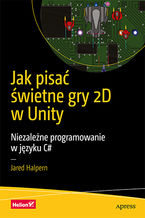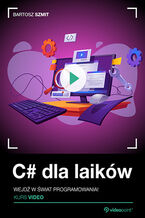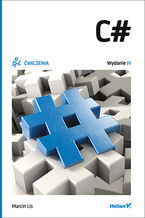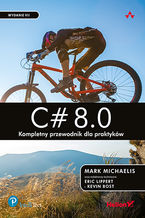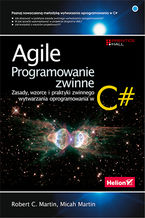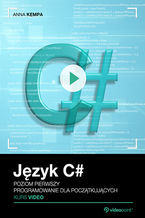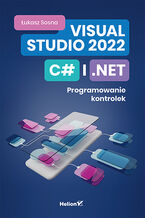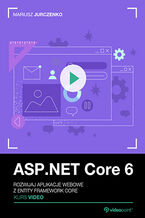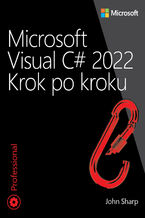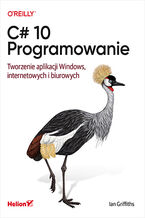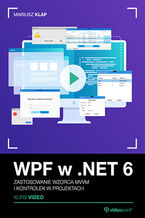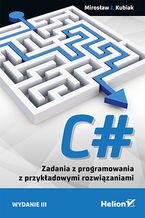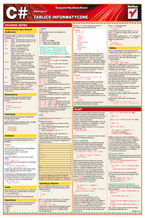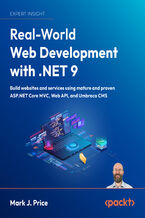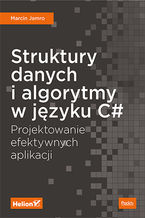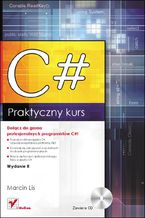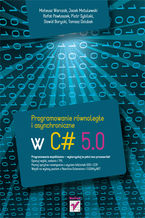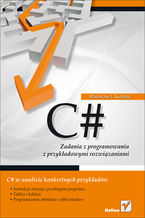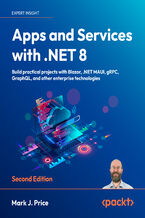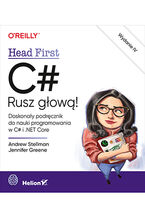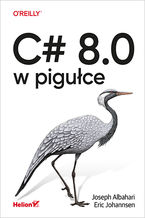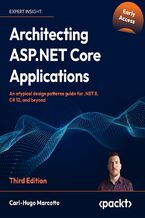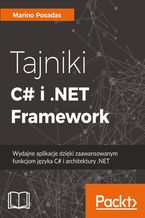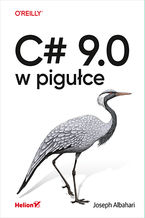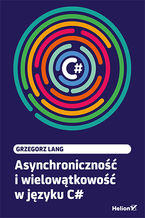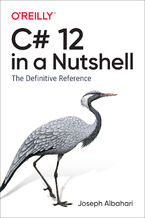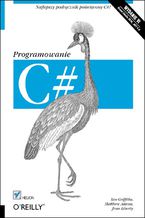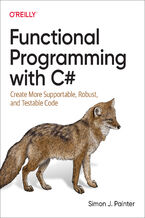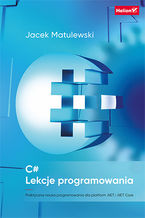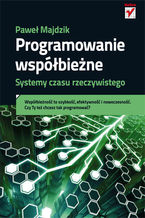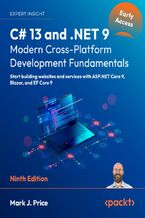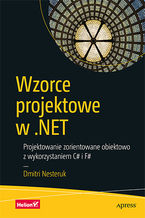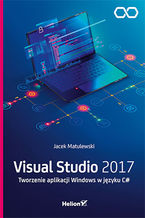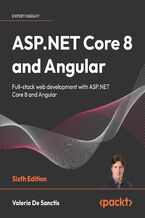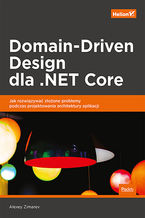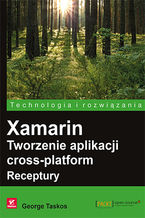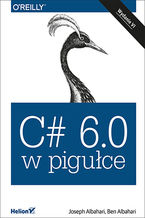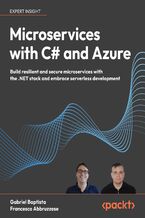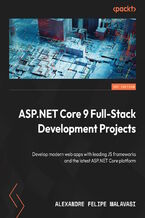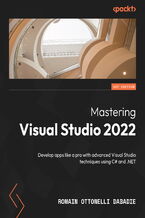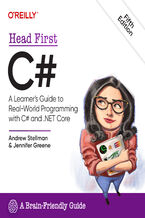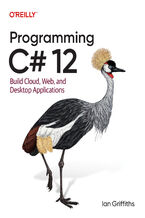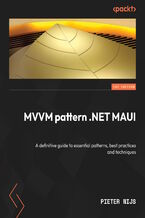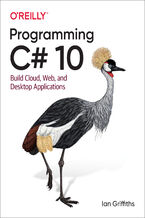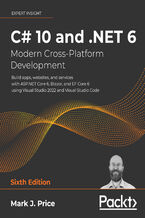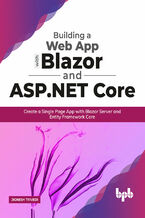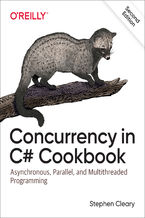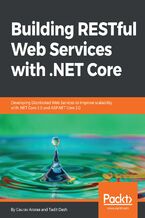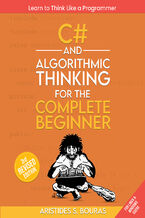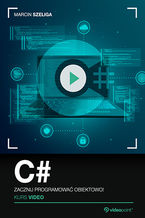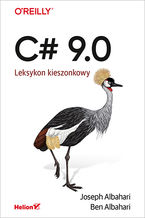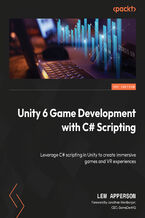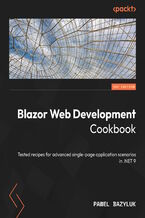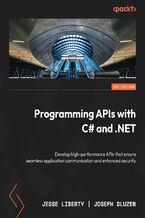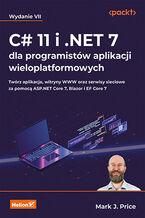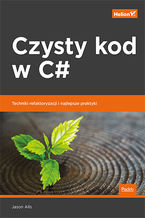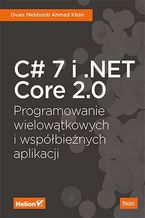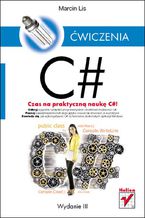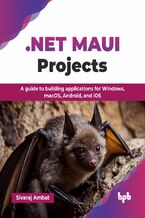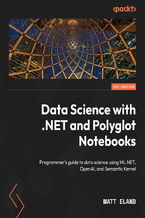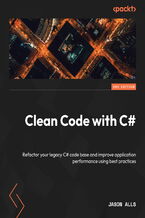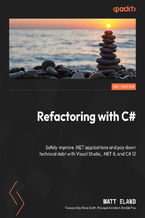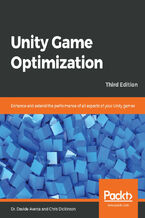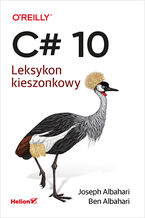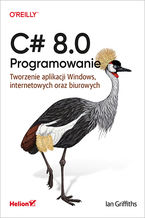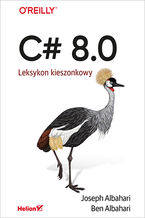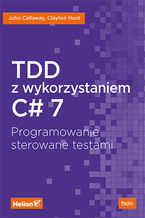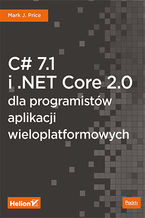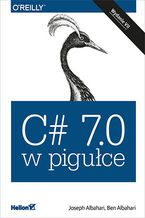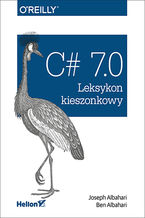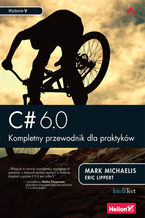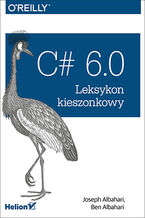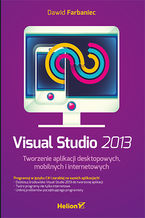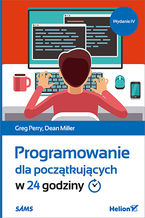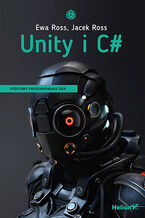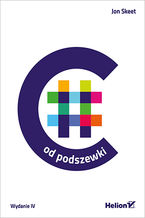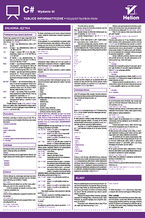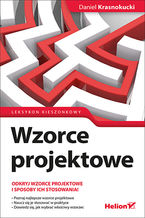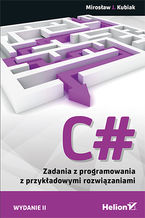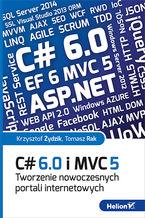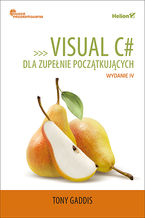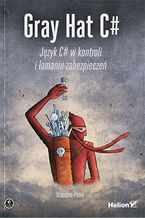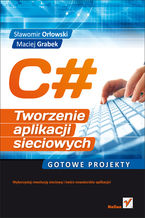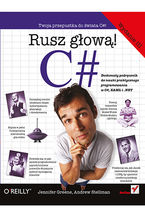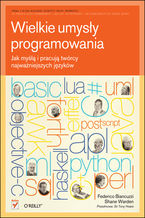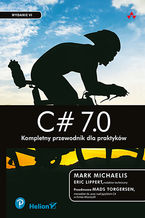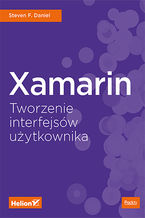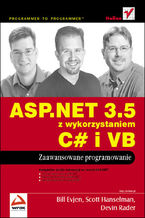W naszej ofercie znajdziesz szeroki wybór książek do nauki C#, które są nie tylko bogatym źródłem wiedzy, ale również doskonałym przewodnikiem po świecie programowania. Nasze publikacje są idealne zarówno dla początkujących, jak i zaawansowanych programistów, którzy chcą poszerzyć swoje umiejętności i wiedzę w tym dynamicznie rozwijającym się języku programowania.
C# - Programowanie - książki
Książki, ebooki, kursy video z kategorii: C# - Programowanie dostępne w księgarni Helion
-
Nowość Promocja
 Rozpowszechnienie się sztucznej inteligencji wiele zmienia na rynku usług IT. Dzięki zastosowaniu takich narzędzi jak ChatGPT część zadań, które do tej pory wymagały mozolnej pracy, można teraz zrealizować szybciej, wspomagając się odpowiednio wytrenowaną i poinstruowaną AI. Jak to zrobić? Od czego zacząć? Jak dołączyć do grona programistów, którzy
Rozpowszechnienie się sztucznej inteligencji wiele zmienia na rynku usług IT. Dzięki zastosowaniu takich narzędzi jak ChatGPT część zadań, które do tej pory wymagały mozolnej pracy, można teraz zrealizować szybciej, wspomagając się odpowiednio wytrenowaną i poinstruowaną AI. Jak to zrobić? Od czego zacząć? Jak dołączyć do grona programistów, którzy- Druk
- PDF + ePub + Mobi pkt
(41,40 zł najniższa cena z 30 dni)
41.40 zł
69.00 zł(-40%) -
Promocja
 C# ma ugruntowaną pozycję jednego z najważniejszych języków programowania. Nowoczesny, wszechstronny i dojrzały, a do tego sukcesywnie rozwijany, zapewnia efektywne tworzenie kodu o wysokiej jakości. Nic nie stoi na przeszkodzie, aby C# stał się Twoim pierwszym językiem programowania i przy okazji pozwolił Ci się świetnie bawić!
C# ma ugruntowaną pozycję jednego z najważniejszych języków programowania. Nowoczesny, wszechstronny i dojrzały, a do tego sukcesywnie rozwijany, zapewnia efektywne tworzenie kodu o wysokiej jakości. Nic nie stoi na przeszkodzie, aby C# stał się Twoim pierwszym językiem programowania i przy okazji pozwolił Ci się świetnie bawić!- Druk
(101,40 zł najniższa cena z 30 dni)
101.40 zł
169.00 zł(-40%) -
Promocja
 Po przyswojeniu zagadnień związanych z językiem C# i aplikacjami konsoli dowiesz się, jak tworzyć praktyczne aplikacje i usługi z wykorzystaniem biblioteki ASP.NET Core, a także wzorzec MVC i technologię Blazor. Zapoznasz się z metodami stosowania wielozadaniowości do poprawy wydajności i skalowalności aplikacji. Przeczytasz też, w jaki sposób ASP.
Po przyswojeniu zagadnień związanych z językiem C# i aplikacjami konsoli dowiesz się, jak tworzyć praktyczne aplikacje i usługi z wykorzystaniem biblioteki ASP.NET Core, a także wzorzec MVC i technologię Blazor. Zapoznasz się z metodami stosowania wielozadaniowości do poprawy wydajności i skalowalności aplikacji. Przeczytasz też, w jaki sposób ASP.- Druk
- PDF + ePub + Mobi pkt
(47,90 zł najniższa cena z 30 dni)
47.90 zł
159.00 zł(-70%) -
Promocja
 Eksperci uważają język C# za flagowy produkt firmy Microsoft udostępniający zarówno wysokopoziomowe abstrakcje, jak i niskopoziomowe mechanizmy, które pozwalają uzyskać maksymalną wydajność aplikacji. Wersja oznaczona numerem 12 wprowadza kilka istotnych usprawnień i nowych funkcji, które mogą znacząco wpłynąć na sposób pisania kodu. Chociaż niektó
Eksperci uważają język C# za flagowy produkt firmy Microsoft udostępniający zarówno wysokopoziomowe abstrakcje, jak i niskopoziomowe mechanizmy, które pozwalają uzyskać maksymalną wydajność aplikacji. Wersja oznaczona numerem 12 wprowadza kilka istotnych usprawnień i nowych funkcji, które mogą znacząco wpłynąć na sposób pisania kodu. Chociaż niektó- Druk
- PDF + ePub + Mobi pkt
(107,40 zł najniższa cena z 30 dni)
107.40 zł
179.00 zł(-40%) -
Promocja
 Połączenie platformy Unity i języka C# zapewnia doskonałe środowisko do tworzenia i rozwijania różnego rodzaju gier komputerowych. To sprawia, że tandem ten jest niezwykle popularny wśród game developerów pragnących szybko i wydajnie osiągać profesjonalne efekty. Jednak sama znajomość narzędzi nie wystarczy, aby sprostać niełatwemu zadaniu zaprojek
Połączenie platformy Unity i języka C# zapewnia doskonałe środowisko do tworzenia i rozwijania różnego rodzaju gier komputerowych. To sprawia, że tandem ten jest niezwykle popularny wśród game developerów pragnących szybko i wydajnie osiągać profesjonalne efekty. Jednak sama znajomość narzędzi nie wystarczy, aby sprostać niełatwemu zadaniu zaprojek- Druk
- PDF + ePub + Mobi pkt
(47,40 zł najniższa cena z 30 dni)
47.40 zł
79.00 zł(-40%) -
Promocja
 Ta książka jest kolejnym, starannie zaktualizowanym wydaniem cenionego i lubianego poradnika, dzięki któremu Twoja praca w języku C# stanie się przyjemna i wydajna. Znajdziesz tu liczne przykłady prezentujące nowe elementy .NET 8: aliasy typów i konstruktory podstawowe, zapewniające spójny i czytelny kod. Nauczysz się stosować klauzule ochronne i u
Ta książka jest kolejnym, starannie zaktualizowanym wydaniem cenionego i lubianego poradnika, dzięki któremu Twoja praca w języku C# stanie się przyjemna i wydajna. Znajdziesz tu liczne przykłady prezentujące nowe elementy .NET 8: aliasy typów i konstruktory podstawowe, zapewniające spójny i czytelny kod. Nauczysz się stosować klauzule ochronne i u- Druk
- PDF + ePub + Mobi pkt
(107,40 zł najniższa cena z 30 dni)
107.40 zł
179.00 zł(-40%) -
Promocja
 Jeśli znasz już podstawy testowania jednostkowego, dzięki tej książce nauczysz się projektowania i pisania testów, które obierają za cel model domeny i pozostałe kluczowe obszary kodu. Ten przejrzyście napisany przewodnik poprowadzi Cię przez proces tworzenia zestawów testowych o optymalnej wartości, bezpiecznej automatyzacji testowania i umiejętne
Jeśli znasz już podstawy testowania jednostkowego, dzięki tej książce nauczysz się projektowania i pisania testów, które obierają za cel model domeny i pozostałe kluczowe obszary kodu. Ten przejrzyście napisany przewodnik poprowadzi Cię przez proces tworzenia zestawów testowych o optymalnej wartości, bezpiecznej automatyzacji testowania i umiejętne- Druk
- PDF + ePub + Mobi pkt
(41,40 zł najniższa cena z 30 dni)
41.40 zł
69.00 zł(-40%) -
Promocja
 Tę praktyczną książkę docenią programiści C#. Zaczniesz od zapoznania się z zasadami działania algorytmów, aby później przejść do różnych struktur danych: tablic, list, stosów, kolejek, słowników i zbiorów. Poszczególne przykłady zostały zilustrowane fragmentami kodu i rysunkami. Opanujesz także sortowanie tablic przy użyciu rozmaitych algorytmów,
Tę praktyczną książkę docenią programiści C#. Zaczniesz od zapoznania się z zasadami działania algorytmów, aby później przejść do różnych struktur danych: tablic, list, stosów, kolejek, słowników i zbiorów. Poszczególne przykłady zostały zilustrowane fragmentami kodu i rysunkami. Opanujesz także sortowanie tablic przy użyciu rozmaitych algorytmów,- Druk
- PDF + ePub + Mobi pkt
(53,40 zł najniższa cena z 30 dni)
53.40 zł
89.00 zł(-40%) -
Promocja

 Utrzymanie czystego kodu ułatwia pracę programistom i przyczynia się do szybszego reagowania na potrzeby odbiorców i wdrażania nowych funkcji. Większa efektywność zespołów programistycznych jest nieoceniona dla funkcjonowania firm. Pozwala zminimalizować ryzyko poważnych awarii i pozytywnie wpływa na wizerunek marki. Jednak utrzymanie czystego kodu
Utrzymanie czystego kodu ułatwia pracę programistom i przyczynia się do szybszego reagowania na potrzeby odbiorców i wdrażania nowych funkcji. Większa efektywność zespołów programistycznych jest nieoceniona dla funkcjonowania firm. Pozwala zminimalizować ryzyko poważnych awarii i pozytywnie wpływa na wizerunek marki. Jednak utrzymanie czystego kodu- Videokurs pkt
(39,90 zł najniższa cena z 30 dni)
118.30 zł
169.00 zł(-30%) -
Promocja

 Unity 6 to najnowsza odsłona silnika Unity do tworzenia gier 2D i 3D, która jeszcze bardziej upraszcza i przyspiesza proces tworzenia własnych produkcji. Nowa wersja znacząco zwiększa wydajność dużych projektów i ułatwia optymalizację gry. Dzięki nowemu renderowi SRP możliwe jest tworzenie fotorealistycznej grafiki i zaawansowanych efektów świetlny
Unity 6 to najnowsza odsłona silnika Unity do tworzenia gier 2D i 3D, która jeszcze bardziej upraszcza i przyspiesza proces tworzenia własnych produkcji. Nowa wersja znacząco zwiększa wydajność dużych projektów i ułatwia optymalizację gry. Dzięki nowemu renderowi SRP możliwe jest tworzenie fotorealistycznej grafiki i zaawansowanych efektów świetlny- Videokurs pkt
(62,55 zł najniższa cena z 30 dni)
97.29 zł
139.00 zł(-30%) -
Promocja
 Jeśli szukasz źródła błyskawicznych odpowiedzi na pytania, jakie się pojawiają podczas pracy z C#, ta książka sprawdzi się idealnie! Została pomyślana tak, aby maksymalnie ułatwić przeglądanie i odnajdywanie potrzebnych treści — jest precyzyjnym, zwięzłym i niezwykle praktycznym przewodnikiem, szczególnie cenionym przez osoby, które znają już
Jeśli szukasz źródła błyskawicznych odpowiedzi na pytania, jakie się pojawiają podczas pracy z C#, ta książka sprawdzi się idealnie! Została pomyślana tak, aby maksymalnie ułatwić przeglądanie i odnajdywanie potrzebnych treści — jest precyzyjnym, zwięzłym i niezwykle praktycznym przewodnikiem, szczególnie cenionym przez osoby, które znają już- Druk
- PDF + ePub + Mobi pkt
(29,94 zł najniższa cena z 30 dni)
29.94 zł
49.90 zł(-40%) -
Promocja
 Te znakomity praktyczny podręcznik pozwoli Ci przećwiczyć używanie i sposób działania wszystkich elementów C# — różnych typów danych, zmiennych i operatorów, instrukcji i tablic. Zobaczysz, jak korzystać z pętli i jak zachowują się obiekty. Poznasz najróżniejsze rodzaje klas, opanujesz wygodne korzystanie z dziedziczenia i nauczysz się obsług
Te znakomity praktyczny podręcznik pozwoli Ci przećwiczyć używanie i sposób działania wszystkich elementów C# — różnych typów danych, zmiennych i operatorów, instrukcji i tablic. Zobaczysz, jak korzystać z pętli i jak zachowują się obiekty. Poznasz najróżniejsze rodzaje klas, opanujesz wygodne korzystanie z dziedziczenia i nauczysz się obsług- Druk
- PDF + ePub + Mobi pkt
Czasowo niedostępna
-
Promocja

 Język C można nazwać ojcem wielu innych, popularniejszych dziś języków programowania. Jego opanowanie pozwala ostatecznie zrozumieć rozwiązania i struktury stosowane między innymi w C++, C# czy nawet Javie. Mimo że jest zaliczany do języków wysokiego poziomu, pozwala pisać stosunkowo lekki i wydajny kod, co nie jest bez znaczenia dla
Język C można nazwać ojcem wielu innych, popularniejszych dziś języków programowania. Jego opanowanie pozwala ostatecznie zrozumieć rozwiązania i struktury stosowane między innymi w C++, C# czy nawet Javie. Mimo że jest zaliczany do języków wysokiego poziomu, pozwala pisać stosunkowo lekki i wydajny kod, co nie jest bez znaczenia dla- Videokurs pkt
(19,80 zł najniższa cena z 30 dni)
60.00 zł
99.00 zł(-39%) -
Promocja
 Oto praktyczny, przystępnie napisany przewodnik, który stanowi wprowadzenie do pracy z technologią Blazor. Opisuje możliwości modeli Server i WebAssembly, przedstawia także krok po kroku proces powstawania aplikacji internetowej. Dzięki temu płynnie przejdziesz do tworzenia projektów Blazor, nauczysz się składni języka Razor, będziesz też weryfikow
Oto praktyczny, przystępnie napisany przewodnik, który stanowi wprowadzenie do pracy z technologią Blazor. Opisuje możliwości modeli Server i WebAssembly, przedstawia także krok po kroku proces powstawania aplikacji internetowej. Dzięki temu płynnie przejdziesz do tworzenia projektów Blazor, nauczysz się składni języka Razor, będziesz też weryfikow- Druk
- PDF + ePub + Mobi pkt
(41,40 zł najniższa cena z 30 dni)
41.40 zł
69.00 zł(-40%) -
Promocja
 W tej praktycznej książce przedstawiono zasady TDD na rzeczywistych przykładach z użyciem popularnych frameworków, takich jak ASP.NET Core i Entity Framework. Po zapoznaniu się z solidnym wprowadzeniem do koncepcji TDD dowiesz się, jak można używać Visual Studio 2022 do tworzenia aplikacji internetowej z wykorzystaniem Entity Framework, a także baz
W tej praktycznej książce przedstawiono zasady TDD na rzeczywistych przykładach z użyciem popularnych frameworków, takich jak ASP.NET Core i Entity Framework. Po zapoznaniu się z solidnym wprowadzeniem do koncepcji TDD dowiesz się, jak można używać Visual Studio 2022 do tworzenia aplikacji internetowej z wykorzystaniem Entity Framework, a także baz- Druk
- PDF + ePub + Mobi pkt
(47,40 zł najniższa cena z 30 dni)
47.40 zł
79.00 zł(-40%) -
Promocja
 Ten szczegółowy przewodnik pozwoli Ci na błyskawiczne zapoznanie się z .NET MAUI i sprawne rozpoczęcie pisania aplikacji za pomocą tej technologii. Zaprezentowano w nim filozofię działania .NET MAUI, jak również przebieg prac nad tworzeniem kompletnej aplikacji wieloplatformowej dla systemów: Android, iOS, macOS i Windows, na podstawie jednego wspó
Ten szczegółowy przewodnik pozwoli Ci na błyskawiczne zapoznanie się z .NET MAUI i sprawne rozpoczęcie pisania aplikacji za pomocą tej technologii. Zaprezentowano w nim filozofię działania .NET MAUI, jak również przebieg prac nad tworzeniem kompletnej aplikacji wieloplatformowej dla systemów: Android, iOS, macOS i Windows, na podstawie jednego wspó- Druk
- PDF + ePub + Mobi pkt
(47,40 zł najniższa cena z 30 dni)
47.40 zł
79.00 zł(-40%) -
Promocja
 Ta książka jest praktycznym wprowadzeniem do tworzenia gier 2D w Unity. Dokładnie wyjaśniono w niej filozofię działania tego środowiska i zasady projektowania gier korzystających z silnika Unity. Starannie opisano takie zagadnienia jak arkusze duszków, dzielone kafelki i mapa kafelków. Omówiono również powiązane z Unity kanały dystrybucyjne, dzięki
Ta książka jest praktycznym wprowadzeniem do tworzenia gier 2D w Unity. Dokładnie wyjaśniono w niej filozofię działania tego środowiska i zasady projektowania gier korzystających z silnika Unity. Starannie opisano takie zagadnienia jak arkusze duszków, dzielone kafelki i mapa kafelków. Omówiono również powiązane z Unity kanały dystrybucyjne, dzięki- Druk
- PDF + ePub + Mobi pkt
(41,40 zł najniższa cena z 30 dni)
41.40 zł
69.00 zł(-40%) -
Promocja

 C# nadaje się do tego celu idealnie. Stworzony przez Microsoft, jest niezwykle uniwersalnym obiektowym językiem programowania. Podejście obiektowe pozwala na powiązanie danych z procedurami, ułatwia pisanie, utrzymanie kodu i jego rozwijanie. Dzięki połączeniu C# z platformą .NET język, początkowo przygotowany do pisania pod Windows, służy również
C# nadaje się do tego celu idealnie. Stworzony przez Microsoft, jest niezwykle uniwersalnym obiektowym językiem programowania. Podejście obiektowe pozwala na powiązanie danych z procedurami, ułatwia pisanie, utrzymanie kodu i jego rozwijanie. Dzięki połączeniu C# z platformą .NET język, początkowo przygotowany do pisania pod Windows, służy również- Videokurs pkt
(29,80 zł najniższa cena z 30 dni)
60.00 zł
149.00 zł(-60%) -
Promocja
 Dzięki tej przystępnej, świetnie napisanej książce dowiesz się, czym jest dług techniczny, co prowadzi do jego powstawania i w jaki sposób można go bezpiecznie zrefaktoryzować przy użyciu nowoczesnych narzędzi dostępnych w środowisku Visual Studio, a także najnowszych składników języka C# 12 i platformy .NET 8. Nauczysz się też korzystać z zaawanso
Dzięki tej przystępnej, świetnie napisanej książce dowiesz się, czym jest dług techniczny, co prowadzi do jego powstawania i w jaki sposób można go bezpiecznie zrefaktoryzować przy użyciu nowoczesnych narzędzi dostępnych w środowisku Visual Studio, a także najnowszych składników języka C# 12 i platformy .NET 8. Nauczysz się też korzystać z zaawanso- Druk
- PDF + ePub + Mobi pkt
(59,40 zł najniższa cena z 30 dni)
59.40 zł
99.00 zł(-40%) -
Promocja

 Zestaw wzorców projektowych zaproponowany przez Gang Czworga jest jednym z fundamentów wiedzy każdego informatyka. Zakres tematyczny niniejszego kursu obejmuje znaczną część tej wiedzy, ze szczególnym uwzględnieniem wzorców strukturalnych i operacyjnych. Nauka wzorców projektowych — po programowaniu proceduralnym i obiektowym — stanowi
Zestaw wzorców projektowych zaproponowany przez Gang Czworga jest jednym z fundamentów wiedzy każdego informatyka. Zakres tematyczny niniejszego kursu obejmuje znaczną część tej wiedzy, ze szczególnym uwzględnieniem wzorców strukturalnych i operacyjnych. Nauka wzorców projektowych — po programowaniu proceduralnym i obiektowym — stanowi- Videokurs pkt
(19,80 zł najniższa cena z 30 dni)
60.00 zł
99.00 zł(-39%) -
Promocja
 C# zintegrowany z platformą .NET pozwala tworzyć różnorodne aplikacje – od gier i programów desktopowych po zaawansowane korporacyjne systemy webowe i mobilne. Znajomość C# i platformy .NET otwiera więc możliwości realizowania projektów, które wykraczają poza podstawowe aplikacje. Dzięki C# możesz tworzyć gry komputerowe z wykorzystaniem siln
C# zintegrowany z platformą .NET pozwala tworzyć różnorodne aplikacje – od gier i programów desktopowych po zaawansowane korporacyjne systemy webowe i mobilne. Znajomość C# i platformy .NET otwiera więc możliwości realizowania projektów, które wykraczają poza podstawowe aplikacje. Dzięki C# możesz tworzyć gry komputerowe z wykorzystaniem siln- Videokurs pkt
(31,80 zł najniższa cena z 30 dni)
60.00 zł
159.00 zł(-62%) -
Promocja
 Znajdziesz tu bez mała półtorej setki ćwiczeń, które pozwolą Ci zrozumieć, jak używać zmiennych i operatorów, stosować instrukcje i wprowadzać dane. Zobaczysz, jak deklarować klasy i tablice, zapewniać obsługę wyjątków i błędów, tworzyć obiekty i całe, działające aplikacje — konsolowe i z graficznym interfejsem użytkownika. Możesz to zrobić w
Znajdziesz tu bez mała półtorej setki ćwiczeń, które pozwolą Ci zrozumieć, jak używać zmiennych i operatorów, stosować instrukcje i wprowadzać dane. Zobaczysz, jak deklarować klasy i tablice, zapewniać obsługę wyjątków i błędów, tworzyć obiekty i całe, działające aplikacje — konsolowe i z graficznym interfejsem użytkownika. Możesz to zrobić w- Druk
- PDF + ePub + Mobi pkt
Czasowo niedostępna
-
Promocja
 To siódme, zaktualizowane i uzupełnione wydanie jednego z najlepszych podręczników programowania, docenianego przez programistów na każdym poziomie zaawansowania. Poza znakomitym samouczkiem języka C# znalazły się tu informacje o poszczególnych metodykach programowania. Książka zawiera także omówienie nowości w C#: typów referencyjnych dopuszczając
To siódme, zaktualizowane i uzupełnione wydanie jednego z najlepszych podręczników programowania, docenianego przez programistów na każdym poziomie zaawansowania. Poza znakomitym samouczkiem języka C# znalazły się tu informacje o poszczególnych metodykach programowania. Książka zawiera także omówienie nowości w C#: typów referencyjnych dopuszczając- Druk
- PDF + ePub + Mobi pkt
(89,40 zł najniższa cena z 30 dni)
89.40 zł
149.00 zł(-40%) -
Promocja

 Jak można temu zaradzić? Pisząc lepszy, bardziej skalowalny kod. Od dłuższego czasu jest to możliwe w aplikacjach tworzonych w środowisku .NET. Od niedawna Microsoft udostępnia wiele udogodnień, które sprawiają, że pisanie takiego kodu jest dziś prostsze, przyjemniejsze i łatwiejsze do zrozumienia. Tworzenie kodu asynchronicznego, znajomość sposobó
Jak można temu zaradzić? Pisząc lepszy, bardziej skalowalny kod. Od dłuższego czasu jest to możliwe w aplikacjach tworzonych w środowisku .NET. Od niedawna Microsoft udostępnia wiele udogodnień, które sprawiają, że pisanie takiego kodu jest dziś prostsze, przyjemniejsze i łatwiejsze do zrozumienia. Tworzenie kodu asynchronicznego, znajomość sposobó- Videokurs pkt
(19,80 zł najniższa cena z 30 dni)
60.00 zł
99.00 zł(-39%) -
Promocja
 Język C# w praktyce. Kurs video. Przetwarzanie danych zewnętrznych jest przeznaczony dla programistów, którzy posiadają już wiedzę o programowaniu obiektowym i komponentowym, a także znają co najmniej jeden język programowania obiektowego. Z pewnością przyda się przypomnienie takich pojęć jak: polimorfizm, dziedziczenie, abstrakcja, hermetyzacja, t
Język C# w praktyce. Kurs video. Przetwarzanie danych zewnętrznych jest przeznaczony dla programistów, którzy posiadają już wiedzę o programowaniu obiektowym i komponentowym, a także znają co najmniej jeden język programowania obiektowego. Z pewnością przyda się przypomnienie takich pojęć jak: polimorfizm, dziedziczenie, abstrakcja, hermetyzacja, t- Videokurs pkt
(23,80 zł najniższa cena z 30 dni)
60.00 zł
119.00 zł(-50%) -
Promocja
 Książka Agile. Programowanie zwinne: zasady, wzorce i praktyki zwinnego wytwarzania oprogramowania w C# to podręcznik metodologii Agile przeznaczony dla twórców oprogramowania korzystających z technologii .NET. Dzięki niemu poznasz podstawowe założenia i postulaty twórców Agile i nauczysz się stosować je w praktyce. Dowiesz się, jak szacować termin
Książka Agile. Programowanie zwinne: zasady, wzorce i praktyki zwinnego wytwarzania oprogramowania w C# to podręcznik metodologii Agile przeznaczony dla twórców oprogramowania korzystających z technologii .NET. Dzięki niemu poznasz podstawowe założenia i postulaty twórców Agile i nauczysz się stosować je w praktyce. Dowiesz się, jak szacować termin- Druk
- PDF + ePub + Mobi pkt
(77,40 zł najniższa cena z 30 dni)
77.40 zł
129.00 zł(-40%) -
Promocja
 Ta książka jest przeznaczona dla doświadczonych programistów C#, którzy chcą nauczyć się technik machine learning, deep learning i sztucznej inteligencji. Opisano tu dostępne narzędzia do uczenia maszynowego, dzięki którym można łatwo budować inteligentne aplikacje .NET wykorzystujące takie rozwiązania jak wykrywanie obrazów lub ruchu, wnioskowanie
Ta książka jest przeznaczona dla doświadczonych programistów C#, którzy chcą nauczyć się technik machine learning, deep learning i sztucznej inteligencji. Opisano tu dostępne narzędzia do uczenia maszynowego, dzięki którym można łatwo budować inteligentne aplikacje .NET wykorzystujące takie rozwiązania jak wykrywanie obrazów lub ruchu, wnioskowanie- Druk
- PDF + ePub + Mobi pkt
Niedostępna
-
Promocja

 Dzięki szkoleniu Język C#. Kurs video. Poziom pierwszy. Programowanie dla początkujących, przygotowanemu przez eksperta z dużym doświadczeniem praktycznym i akademickim, opanujesz solidne podstawy języka C#. Nabędziesz także umiejętności, które będziesz mógł wykorzystać w swojej karierze informatycznej. Założeniem twórcó
Dzięki szkoleniu Język C#. Kurs video. Poziom pierwszy. Programowanie dla początkujących, przygotowanemu przez eksperta z dużym doświadczeniem praktycznym i akademickim, opanujesz solidne podstawy języka C#. Nabędziesz także umiejętności, które będziesz mógł wykorzystać w swojej karierze informatycznej. Założeniem twórcó- Videokurs pkt
(39,90 zł najniższa cena z 30 dni)
69.30 zł
99.00 zł(-30%) -
Promocja
 Nie trzeba siedzieć po uszy w programowaniu, by zauważyć pewną regułę: lwia część książek poświęconych temu zagadnieniu została napisana w podobny sposób. I nie chodzi o styl, środowisko czy język, lecz o strukturę. Prawidłowość tę zauważył Łukasz Sosna, który do zagadnienia programowania w języku C# i użytkowania środowiska .NET postanowił podejść
Nie trzeba siedzieć po uszy w programowaniu, by zauważyć pewną regułę: lwia część książek poświęconych temu zagadnieniu została napisana w podobny sposób. I nie chodzi o styl, środowisko czy język, lecz o strukturę. Prawidłowość tę zauważył Łukasz Sosna, który do zagadnienia programowania w języku C# i użytkowania środowiska .NET postanowił podejść- Druk
- PDF + ePub + Mobi pkt
(29,94 zł najniższa cena z 30 dni)
29.94 zł
49.90 zł(-40%) -
Promocja

 Nasz kurs bowiem pozwala zdobyć kompleksową wiedzę i umiejętności, jakich potrzebujesz do tego, by zbudować swoją pierwszą aplikację internetową przy użyciu platformy ASP.NET Core 6. Stworzysz aplikację od początku do końca w sposób maksymalnie praktyczny, wspomagając się w tym celu zintegrowanym środowiskiem programistycznym Visual Studio 2022. Po
Nasz kurs bowiem pozwala zdobyć kompleksową wiedzę i umiejętności, jakich potrzebujesz do tego, by zbudować swoją pierwszą aplikację internetową przy użyciu platformy ASP.NET Core 6. Stworzysz aplikację od początku do końca w sposób maksymalnie praktyczny, wspomagając się w tym celu zintegrowanym środowiskiem programistycznym Visual Studio 2022. Po- Videokurs pkt
(125,30 zł najniższa cena z 30 dni)
125.30 zł
179.00 zł(-30%) -
Promocja
 Praktyczny przewodnik po podstawach Visual C# przy użyciu Visual Studio 2022 Poszerz swoje umiejetności i samodzielnie poznawaj podstawy programowania w najnowszej wersji Visual C# i Visual Studio 2022. Znajdziesz tu niezbędne wskazówki, ćwiczenia i przykładowy kod, niezbędne do tworzenia skutecznych, skalowalnych, połączonych z chmurą aplikacji
Praktyczny przewodnik po podstawach Visual C# przy użyciu Visual Studio 2022 Poszerz swoje umiejetności i samodzielnie poznawaj podstawy programowania w najnowszej wersji Visual C# i Visual Studio 2022. Znajdziesz tu niezbędne wskazówki, ćwiczenia i przykładowy kod, niezbędne do tworzenia skutecznych, skalowalnych, połączonych z chmurą aplikacji- PDF + ePub pkt
(70,02 zł najniższa cena z 30 dni)
126.65 zł
149.00 zł(-15%) -
Promocja
 Książka tak, napisana z myślą o doświadczonych programistach, zawiera wiele przykładowych programów, które pozwolą Ci poznać praktyczne tajniki języka, takie jak typy ogólne, LINQ oraz techniki programowania asynchronicznego. Następnie poznasz najnowsze możliwości platformy .NET 6 oraz języka C# 9.0 oraz 10.0 takie jak: rekordy, rozszerzone możliwo
Książka tak, napisana z myślą o doświadczonych programistach, zawiera wiele przykładowych programów, które pozwolą Ci poznać praktyczne tajniki języka, takie jak typy ogólne, LINQ oraz techniki programowania asynchronicznego. Następnie poznasz najnowsze możliwości platformy .NET 6 oraz języka C# 9.0 oraz 10.0 takie jak: rekordy, rozszerzone możliwo- Druk
- PDF + ePub + Mobi pkt
(101,40 zł najniższa cena z 30 dni)
101.40 zł
169.00 zł(-40%) -
Promocja

 Zapewne obiła Ci się o uszy nazwa Windows Presentation Foundation, w skrócie WPF. Dla przypomnienia: kryje się pod nią silnik graficzny i API, bazujący na .NET, wchodzący w skład .NET Framework. Do zadań WPF należy integracja interfejsu użytkownika, grafiki 2D i 3D, multimediów, dokumentów, a także generowanie/rozpoznawanie mowy. Z funkcjonującymi
Zapewne obiła Ci się o uszy nazwa Windows Presentation Foundation, w skrócie WPF. Dla przypomnienia: kryje się pod nią silnik graficzny i API, bazujący na .NET, wchodzący w skład .NET Framework. Do zadań WPF należy integracja interfejsu użytkownika, grafiki 2D i 3D, multimediów, dokumentów, a także generowanie/rozpoznawanie mowy. Z funkcjonującymi- Videokurs pkt
(104,30 zł najniższa cena z 30 dni)
104.30 zł
149.00 zł(-30%) -
Promocja
 C# - wieloparadygmatowy język programowania opracowany przez firmę Microsoft - z roku na rok zdobywa coraz większą popularność wśród profesjonalistów z branży IT. Przejrzysta struktura kodu, wygoda stosowania, potężne możliwości i wsparcie ze strony platformy .NET - wszystko to sprawia, że są duże szanse, by ten trend utrzymywał się przez kolejne l
C# - wieloparadygmatowy język programowania opracowany przez firmę Microsoft - z roku na rok zdobywa coraz większą popularność wśród profesjonalistów z branży IT. Przejrzysta struktura kodu, wygoda stosowania, potężne możliwości i wsparcie ze strony platformy .NET - wszystko to sprawia, że są duże szanse, by ten trend utrzymywał się przez kolejne l- Druk
- PDF + ePub + Mobi pkt
Czasowo niedostępna
-
Promocja
 Tablice informatyczne. C#" to podręczne zestawienie niezbędnych programiście informacji dotyczących języka C#. Pracując pod presją czasu, nie zawsze można znaleźć czas na wertowanie grubych książek. Niezależnie od tego, czy tworzysz aplikacje dla systemu Windows, aplikacje WWW, czy usługi sieciowe, docenisz tablice informatyczne.
Tablice informatyczne. C#" to podręczne zestawienie niezbędnych programiście informacji dotyczących języka C#. Pracując pod presją czasu, nie zawsze można znaleźć czas na wertowanie grubych książek. Niezależnie od tego, czy tworzysz aplikacje dla systemu Windows, aplikacje WWW, czy usługi sieciowe, docenisz tablice informatyczne.- Druk
(7,74 zł najniższa cena z 30 dni)
7.74 zł
12.90 zł(-40%) -
Promocja
 This guide helps .NET developers build secure, testable, and scalable web apps using MVC and Web API, covering best practices for testing, security, and deployment, while also implementing Umbraco CMS for content management.
This guide helps .NET developers build secure, testable, and scalable web apps using MVC and Web API, covering best practices for testing, security, and deployment, while also implementing Umbraco CMS for content management.-
- PDF + ePub pkt
(50,90 zł najniższa cena z 30 dni)
125.10 zł
139.00 zł(-10%) -
-
Promocja
 Dzięki tej książce nauczysz się używania struktur danych i implementacji najważniejszych algorytmów w języku C#. Najpierw zapoznasz się z najprostszymi strukturami danych o swobodnym dostępie — z tablicami oraz listami. Wyjaśniono tu również działanie struktur danych o dostępie sekwencyjnym, opartych na stosach i kolejkach. Przedstawiono zast
Dzięki tej książce nauczysz się używania struktur danych i implementacji najważniejszych algorytmów w języku C#. Najpierw zapoznasz się z najprostszymi strukturami danych o swobodnym dostępie — z tablicami oraz listami. Wyjaśniono tu również działanie struktur danych o dostępie sekwencyjnym, opartych na stosach i kolejkach. Przedstawiono zast- Druk
- PDF + ePub + Mobi pkt
(41,40 zł najniższa cena z 30 dni)
41.40 zł
69.00 zł(-40%) -
Promocja
 Niezależnie od tego, czy dopiero zaczynasz swoją przygodę z programowaniem, czy też masz już pewne doświadczenie w korzystaniu z innych języków, książka „C#. Praktyczny kurs. Wydanie II ” będzie dla Ciebie doskonałym wprowadzeniem w arkana praktycznego stosowania języka C#. Dzięki niej poznasz wszystkie niezbędne informacje teoretyczne
Niezależnie od tego, czy dopiero zaczynasz swoją przygodę z programowaniem, czy też masz już pewne doświadczenie w korzystaniu z innych języków, książka „C#. Praktyczny kurs. Wydanie II ” będzie dla Ciebie doskonałym wprowadzeniem w arkana praktycznego stosowania języka C#. Dzięki niej poznasz wszystkie niezbędne informacje teoretyczne- Druk
- PDF + ePub + Mobi pkt
Niedostępna
-
Promocja

 Szkolenie, które Ci dziś proponujemy, pozwoli Ci opanować tajniki pracy z silnikiem graficznym i API Windows Presentation Foundation, w skrócie WPF, znanym pod kodową nazwą Avalon. WPF bazuje na platformie programistycznej Microsoftu .NET 3 i wchodzi w skład WinFX. Możliwości ma naprawdę spore: integruje interfejs użytkownika, grafikę
Szkolenie, które Ci dziś proponujemy, pozwoli Ci opanować tajniki pracy z silnikiem graficznym i API Windows Presentation Foundation, w skrócie WPF, znanym pod kodową nazwą Avalon. WPF bazuje na platformie programistycznej Microsoftu .NET 3 i wchodzi w skład WinFX. Możliwości ma naprawdę spore: integruje interfejs użytkownika, grafikę- Videokurs pkt
(153,29 zł najniższa cena z 30 dni)
153.29 zł
219.00 zł(-30%) -
Promocja
 Jeśli chcesz być naprawdę świetnym programistą C#, tworzącym aplikacje na platformę .NET, a do tej pory nie przestudiowałeś jeszcze porządnie kwestii współbieżności, pora to nadrobić. W tej książce znajdziesz informacje o podstawach tej technologii, takich jak wątki, a także o klasycznych pułapkach związanych z programowaniem współbieżnym. Kolejne
Jeśli chcesz być naprawdę świetnym programistą C#, tworzącym aplikacje na platformę .NET, a do tej pory nie przestudiowałeś jeszcze porządnie kwestii współbieżności, pora to nadrobić. W tej książce znajdziesz informacje o podstawach tej technologii, takich jak wątki, a także o klasycznych pułapkach związanych z programowaniem współbieżnym. Kolejne- Druk
- PDF + ePub + Mobi pkt
Programowanie równoległe i asynchroniczne w C# 5.0
Mateusz Warczak, Jacek Matulewski, Rafał Pawłaszek, Piotr Sybilski, Dawid Borycki, Tomasz Dziubak
(41,40 zł najniższa cena z 30 dni)
41.40 zł
69.00 zł(-40%) -
Promocja
 Książka „C#. Zadania z programowania z przykładowymi rozwiązaniami” na konkretnych przykładach pokaże Ci, jak program napisany w języku C# komunikuje się z użytkownikiem poprzez operacje wejścia-wyjścia. Dowiesz się, jakie operatory będą Ci potrzebne i do czego można ich używać. Poznasz instrukcje sterujące przebiegiem programu (iteracy
Książka „C#. Zadania z programowania z przykładowymi rozwiązaniami” na konkretnych przykładach pokaże Ci, jak program napisany w języku C# komunikuje się z użytkownikiem poprzez operacje wejścia-wyjścia. Dowiesz się, jakie operatory będą Ci potrzebne i do czego można ich używać. Poznasz instrukcje sterujące przebiegiem programu (iteracy- Druk
- PDF + ePub + Mobi pkt
Niedostępna
-
Promocja
 This book will help .NET developers build on their existing knowledge and learn how to make the most of specialized .NET libraries to improve performance, scalability, security, and the user experience of their apps and services. Covering the most up-to-date topics and developments, this book will provide you with new skills to tackle real-world ch
This book will help .NET developers build on their existing knowledge and learn how to make the most of specialized .NET libraries to improve performance, scalability, security, and the user experience of their apps and services. Covering the most up-to-date topics and developments, this book will provide you with new skills to tackle real-world ch-
- PDF + ePub pkt
(29,90 zł najniższa cena z 30 dni)
125.10 zł
139.00 zł(-10%) -
-
Promocja
 Oto siódme, uzupełnione i zaktualizowane wydanie cenionego podręcznika (dodano do niego kilka nowych rozdziałów). Dzięki lekturze poznasz od podstaw koncepcje programowania w języku C# i płynnie przejdziesz do tworzenia gier w Unity. Nauczysz się pisać skrypty implementujące prostą mechanikę gier, programować proceduralnie i zwiększać złożoność swo
Oto siódme, uzupełnione i zaktualizowane wydanie cenionego podręcznika (dodano do niego kilka nowych rozdziałów). Dzięki lekturze poznasz od podstaw koncepcje programowania w języku C# i płynnie przejdziesz do tworzenia gier w Unity. Nauczysz się pisać skrypty implementujące prostą mechanikę gier, programować proceduralnie i zwiększać złożoność swo- Druk
- PDF + ePub + Mobi pkt
(59,40 zł najniższa cena z 30 dni)
59.40 zł
99.00 zł(-40%) -
Promocja
 MonoGame. Podstawowe koncepcje grafiki 3D dotyczy programowania grafiki 3D, co oznacza, że do jej tworzenia wykorzystuje się kod, a nie edytor sceny obsługiwany myszką. Autorzy wyczerpująco omówili kluczowe zagadnienia, jak rozdzielenie definiowanie figur i brył, poruszanie nimi na scenie, oświetlenie i cienie, mieszanie kolorów czy odwzorowanie te
MonoGame. Podstawowe koncepcje grafiki 3D dotyczy programowania grafiki 3D, co oznacza, że do jej tworzenia wykorzystuje się kod, a nie edytor sceny obsługiwany myszką. Autorzy wyczerpująco omówili kluczowe zagadnienia, jak rozdzielenie definiowanie figur i brył, poruszanie nimi na scenie, oświetlenie i cienie, mieszanie kolorów czy odwzorowanie te- Druk
- PDF + ePub + Mobi pkt
(41,40 zł najniższa cena z 30 dni)
41.40 zł
69.00 zł(-40%) -
Promocja
 C# jest dziś uważany za jeden z najważniejszych języków programowania. Nowoczesny, wszechstronny, dojrzały i sukcesywnie rozwijany, zapewnia efektywne tworzenie kodu wysokiej jakości. Profesjonalni programiści, którzy pisali już kod w C++ lub Javie, bardzo często wybierają właśnie C#. Nic nie stoi na przeszkodzie, aby był pierwszym językiem program
C# jest dziś uważany za jeden z najważniejszych języków programowania. Nowoczesny, wszechstronny, dojrzały i sukcesywnie rozwijany, zapewnia efektywne tworzenie kodu wysokiej jakości. Profesjonalni programiści, którzy pisali już kod w C++ lub Javie, bardzo często wybierają właśnie C#. Nic nie stoi na przeszkodzie, aby był pierwszym językiem program- Druk
Czasowo niedostępna
-
Promocja
 To kolejne, przejrzane i zaktualizowane wydanie doskonałego podręcznika dla programistów. Znalazły się tu zwięzłe i dokładne informacje na temat języka C#, Common Language Runtime (CLR) oraz platformy .NET Core. Zaprezentowano precyzyjne opisy pojęć i konkretne przypadki użycia, a poszczególne zagadnienia potraktowano dogłębnie i od strony praktycz
To kolejne, przejrzane i zaktualizowane wydanie doskonałego podręcznika dla programistów. Znalazły się tu zwięzłe i dokładne informacje na temat języka C#, Common Language Runtime (CLR) oraz platformy .NET Core. Zaprezentowano precyzyjne opisy pojęć i konkretne przypadki użycia, a poszczególne zagadnienia potraktowano dogłębnie i od strony praktycz- Druk
- PDF + ePub + Mobi pkt
(89,40 zł najniższa cena z 30 dni)
89.40 zł
149.00 zł(-40%) -
Promocja
 Ten podręcznik ułatwi Ci szybkie opanowanie podstaw języka C#. Autor, doświadczony guru IT, Gaurav Aroraa, proponuje 7-dniowy plan działania, którego realizacja da Ci pełne spektrum umiejętności programistycznych. Zacznij już teraz kurs języka C#! Językowa biegłość przyniesie Ci satysfakcję i pewność siebie, poprawi Twoją pozycję w zespole czy na r
Ten podręcznik ułatwi Ci szybkie opanowanie podstaw języka C#. Autor, doświadczony guru IT, Gaurav Aroraa, proponuje 7-dniowy plan działania, którego realizacja da Ci pełne spektrum umiejętności programistycznych. Zacznij już teraz kurs języka C#! Językowa biegłość przyniesie Ci satysfakcję i pewność siebie, poprawi Twoją pozycję w zespole czy na r- Druk
- PDF + ePub + Mobi pkt
Niedostępna
-
Promocja
 Explore ASP.NET Core with this unique guide to crafting resilient and adaptable applications with the GoF design patterns. Featuring architectural principles, SOLID, REST, layering, microservices, and feature-oriented design, and more.
Explore ASP.NET Core with this unique guide to crafting resilient and adaptable applications with the GoF design patterns. Featuring architectural principles, SOLID, REST, layering, microservices, and feature-oriented design, and more.-
- PDF + ePub pkt
(29,90 zł najniższa cena z 30 dni)
125.10 zł
139.00 zł(-10%) -
-
Promocja
 Książka Tajniki C# i .NET Framework szczegółowo przedstawia zagadnienia związane z językiem C# 6.0/7.0 oraz platformą .NET 4.6 pozwalając zrozumieć, jak działa ta platforma podczas wykonywania kodu i jak wykorzystać tę wiedzę do pisania wydajnych aplikacji. Pozwala w pełni spożytkować nową rewolucję w programowaniu .NET, w tym otwarty kod źr
Książka Tajniki C# i .NET Framework szczegółowo przedstawia zagadnienia związane z językiem C# 6.0/7.0 oraz platformą .NET 4.6 pozwalając zrozumieć, jak działa ta platforma podczas wykonywania kodu i jak wykorzystać tę wiedzę do pisania wydajnych aplikacji. Pozwala w pełni spożytkować nową rewolucję w programowaniu .NET, w tym otwarty kod źr(39,90 zł najniższa cena z 30 dni)
76.49 zł
89.99 zł(-15%) -
Promocja
 To zaktualizowane wydanie znakomitego podręcznika dla programistów. Zawiera zwięzłe i dokładne informacje na temat języka C#, Common Language Runtime (CLR), a także biblioteki klas .NET 5 Base Class Library (BCL). Nowe składniki języka C# 9.0 i związanej z nim platformy specjalnie oznaczono, dzięki czemu książka może też służyć jako podręcznik do n
To zaktualizowane wydanie znakomitego podręcznika dla programistów. Zawiera zwięzłe i dokładne informacje na temat języka C#, Common Language Runtime (CLR), a także biblioteki klas .NET 5 Base Class Library (BCL). Nowe składniki języka C# 9.0 i związanej z nim platformy specjalnie oznaczono, dzięki czemu książka może też służyć jako podręcznik do n- Druk
- PDF + ePub + Mobi pkt
(107,40 zł najniższa cena z 30 dni)
107.40 zł
179.00 zł(-40%) -
Promocja
 Programowanie wielowątkowe pozwala wykonywać różne czynności z wykorzystaniem więcej niż jednego wątku. W efekcie zwiększa się wydajność operacji, które były ograniczone parametrami procesora. W dodatku dzięki zastosowaniu programowania wielowątkowego zadania można wykonywać w tle, bez pogorszenia responsywności aplikacji. Asynchroniczność umożliwi
Programowanie wielowątkowe pozwala wykonywać różne czynności z wykorzystaniem więcej niż jednego wątku. W efekcie zwiększa się wydajność operacji, które były ograniczone parametrami procesora. W dodatku dzięki zastosowaniu programowania wielowątkowego zadania można wykonywać w tle, bez pogorszenia responsywności aplikacji. Asynchroniczność umożliwi- Druk
- PDF + ePub + Mobi pkt
Czasowo niedostępna
-
Promocja
 Ebook available on November 16, 2023When you have questions about C# 12 or .NET 8, this best-selling guide has the answers you need. C# is a language of unusual flexibility and breadth, and with its continual growth, there's always so much more to learn. In the tradition of O'Reilly's Nutshell guides, this thoroughly updated edition is simply the b
Ebook available on November 16, 2023When you have questions about C# 12 or .NET 8, this best-selling guide has the answers you need. C# is a language of unusual flexibility and breadth, and with its continual growth, there's always so much more to learn. In the tradition of O'Reilly's Nutshell guides, this thoroughly updated edition is simply the b-
- ePub + Mobi pkt
(29,90 zł najniższa cena z 30 dni)
203.15 zł
239.00 zł(-15%) -
-
Promocja
 Ten bestsellerowy podręcznik pozwoli Ci błyskawicznie poznać wszystkie niuanse języka C# 4.0. Najnowsze wydanie zostało zaktualizowane o nowości w C# oraz zawiera opis tego języka i platformy .NET. W trakcie lektury nauczysz się tworzyć skomplikowane programy przy użyciu technik programowania obiektowego i funkcjonalnego. Ponadto sprawdzisz, jaki p
Ten bestsellerowy podręcznik pozwoli Ci błyskawicznie poznać wszystkie niuanse języka C# 4.0. Najnowsze wydanie zostało zaktualizowane o nowości w C# oraz zawiera opis tego języka i platformy .NET. W trakcie lektury nauczysz się tworzyć skomplikowane programy przy użyciu technik programowania obiektowego i funkcjonalnego. Ponadto sprawdzisz, jaki p- Druk
- PDF + ePub + Mobi pkt
Czasowo niedostępna
-
Promocja
 After decades of relative obscurity, functional programming is finally coming into its own. With concise, easy-to-read code that supports asynchronous, concurrent processing, aspects of functional programming have begun to appear in several traditionally object-oriented languages such as C# and Java. This practical book shows C# programmers how to
After decades of relative obscurity, functional programming is finally coming into its own. With concise, easy-to-read code that supports asynchronous, concurrent processing, aspects of functional programming have begun to appear in several traditionally object-oriented languages such as C# and Java. This practical book shows C# programmers how to-
- ePub + Mobi pkt
(29,90 zł najniższa cena z 30 dni)
228.65 zł
269.00 zł(-15%) -
-
Promocja
 Książka, którą trzymasz w ręku, to znakomity podręcznik do nauki programowania od podstaw. Autor, wieloletni wykładowca akademicki i nauczyciel studentów informatyki, proponuje naukę programowania w języku C#. To wybór nieprzypadkowy. C# jest nowoczesnym, obiektowym, stale rozwijanym i popularnym językiem, którym opiekuje się firma Microsoft. Dodat
Książka, którą trzymasz w ręku, to znakomity podręcznik do nauki programowania od podstaw. Autor, wieloletni wykładowca akademicki i nauczyciel studentów informatyki, proponuje naukę programowania w języku C#. To wybór nieprzypadkowy. C# jest nowoczesnym, obiektowym, stale rozwijanym i popularnym językiem, którym opiekuje się firma Microsoft. Dodat- Druk
- PDF + ePub + Mobi pkt
Czasowo niedostępna
-
Promocja
 Tworzenie efektywnych aplikacji współbieżnych wciąż jednak wymaga dużej, specjalistycznej wiedzy dotyczącej systemów operacyjnych oraz programowania nisko- i wysokopoziomowego, o czym przekonało się wielu studentów kierunków informatycznych i profesjonalnych programistów. Na szczęście teraz wszyscy mogą sięgnąć po książkę „Programowanie współ
Tworzenie efektywnych aplikacji współbieżnych wciąż jednak wymaga dużej, specjalistycznej wiedzy dotyczącej systemów operacyjnych oraz programowania nisko- i wysokopoziomowego, o czym przekonało się wielu studentów kierunków informatycznych i profesjonalnych programistów. Na szczęście teraz wszyscy mogą sięgnąć po książkę „Programowanie współ- Druk
- PDF + ePub + Mobi pkt
Niedostępna
-
Promocja
 Whether you're new to C# or returning, this updated guide teaches object-oriented programming, database work with Entity Framework Core, and web development using ASP.NET Core and Blazor, all while covering the latest technologies
Whether you're new to C# or returning, this updated guide teaches object-oriented programming, database work with Entity Framework Core, and web development using ASP.NET Core and Blazor, all while covering the latest technologies-
- PDF + ePub pkt
(50,90 zł najniższa cena z 30 dni)
152.10 zł
169.00 zł(-10%) -
-
Promocja
 To książka przeznaczona dla programistów C#, którzy chcą poszerzyć wiedzę na temat sztuki programowania dzięki wykorzystaniu nowoczesnych technik projektowych do rozwiązywania konkretnych problemów programistycznych w optymalny sposób. Dogłębnie przedstawiono tu implementację klasycznych wzorców wraz ze wskazówkami dotyczącymi ich możliwości. Omówi
To książka przeznaczona dla programistów C#, którzy chcą poszerzyć wiedzę na temat sztuki programowania dzięki wykorzystaniu nowoczesnych technik projektowych do rozwiązywania konkretnych problemów programistycznych w optymalny sposób. Dogłębnie przedstawiono tu implementację klasycznych wzorców wraz ze wskazówkami dotyczącymi ich możliwości. Omówi- Druk
- PDF + ePub + Mobi pkt
Czasowo niedostępna
-
Promocja
 Microsoft Visual Studio to znakomite środowisko programistyczne, w którym bardzo wydajnie, a przy tym z przyjemnością, można projektować i testować aplikacje desktopowe, mobilne i webowe w kilku językach programowania, z wykorzystaniem bogatego zbioru bibliotek oraz interesujących dodatków dostępnych w usłudze NuGet, wydatnie skracających czas prac
Microsoft Visual Studio to znakomite środowisko programistyczne, w którym bardzo wydajnie, a przy tym z przyjemnością, można projektować i testować aplikacje desktopowe, mobilne i webowe w kilku językach programowania, z wykorzystaniem bogatego zbioru bibliotek oraz interesujących dodatków dostępnych w usłudze NuGet, wydatnie skracających czas prac- Druk
- PDF + ePub + Mobi pkt
(53,40 zł najniższa cena z 30 dni)
53.40 zł
89.00 zł(-40%) -
Promocja
 This book covers everything from setting up ASP.NET Core 8 and modern Angular to deploying robust web applications in Windows, Linux, and Azure. Learn advanced techniques in data handling, API usage, UI design, and security
This book covers everything from setting up ASP.NET Core 8 and modern Angular to deploying robust web applications in Windows, Linux, and Azure. Learn advanced techniques in data handling, API usage, UI design, and security-
- PDF + ePub pkt
(29,90 zł najniższa cena z 30 dni)
134.10 zł
149.00 zł(-10%) -
-
Promocja
 Dzięki tej książce zrozumiesz praktyczne znaczenie złożoności dziedziny i behawioralnych aspektów języka dziedzinowego. Poznasz podstawowe zasady DDD i nauczysz się używać takich narzędzi jak EventStorming, Event Sourcing i CQRS. Dowiesz się, jak stosuje się DDD do różnych stylów architektonicznych, takich jak REST, systemy reaktywne i mikrousługi.
Dzięki tej książce zrozumiesz praktyczne znaczenie złożoności dziedziny i behawioralnych aspektów języka dziedzinowego. Poznasz podstawowe zasady DDD i nauczysz się używać takich narzędzi jak EventStorming, Event Sourcing i CQRS. Dowiesz się, jak stosuje się DDD do różnych stylów architektonicznych, takich jak REST, systemy reaktywne i mikrousługi.- Druk
- PDF + ePub + Mobi pkt
Niedostępna
-
Promocja
 W tej książce opisano zasady programowania aspektowego przy tworzeniu architektury aplikacji, która działa efektywnie na każdej platformie i korzysta z wbudowanego lokalizatora usług. Przedstawiono dobre praktyki tworzenia i dostosowywania kontrolek Xamarin.Forms ListView, grupowania elementów, list szybkiego dostępu i niestandardowych komórek. Opi
W tej książce opisano zasady programowania aspektowego przy tworzeniu architektury aplikacji, która działa efektywnie na każdej platformie i korzysta z wbudowanego lokalizatora usług. Przedstawiono dobre praktyki tworzenia i dostosowywania kontrolek Xamarin.Forms ListView, grupowania elementów, list szybkiego dostępu i niestandardowych komórek. Opi- Druk
- PDF + ePub + Mobi pkt
Niedostępna
-
Promocja
 Niniejsza książka jest zwięzłym kompendium wiedzy o C#, CLR oraz o związanej z C# platformie. Napisano ją z myślą o programistach na co najmniej średnim poziomie zaawansowania. W zrozumiały, a równocześnie dogłębny sposób wyjaśniono takie trudne kwestie, jak współbieżność, bezpieczeństwo i domeny aplikacji. Informacje o nowych składnikach języka C#
Niniejsza książka jest zwięzłym kompendium wiedzy o C#, CLR oraz o związanej z C# platformie. Napisano ją z myślą o programistach na co najmniej średnim poziomie zaawansowania. W zrozumiały, a równocześnie dogłębny sposób wyjaśniono takie trudne kwestie, jak współbieżność, bezpieczeństwo i domeny aplikacji. Informacje o nowych składnikach języka C#- Druk
- PDF + ePub + Mobi pkt
(77,40 zł najniższa cena z 30 dni)
77.40 zł
129.00 zł(-40%) -
Promocja
 Enter the world of modern cloud and distributed applications with the .NET stack. This book explores realistic use cases, cost considerations, and limitations of microservices applications and serverless development.
Enter the world of modern cloud and distributed applications with the .NET stack. This book explores realistic use cases, cost considerations, and limitations of microservices applications and serverless development.-
- PDF + ePub pkt
(50,90 zł najniższa cena z 30 dni)
125.10 zł
139.00 zł(-10%) -
-
Promocja
 This book offers a comprehensive introduction to ASP.NET Core as the foundation for full-stack development, and helps you develop modern web apps with leading JavaScript frameworks like Angular, React, and Vue.js.
This book offers a comprehensive introduction to ASP.NET Core as the foundation for full-stack development, and helps you develop modern web apps with leading JavaScript frameworks like Angular, React, and Vue.js.-
- PDF + ePub pkt
(50,90 zł najniższa cena z 30 dni)
116.10 zł
129.00 zł(-10%) -
-
Promocja
 This book is your guide to learning all about core development, web, ML, and MAUI. You'll create robust solutions, ranging from advanced debugging to cloud integration. Craft your Visual Studio experience and stay ahead in the .NET world.
This book is your guide to learning all about core development, web, ML, and MAUI. You'll create robust solutions, ranging from advanced debugging to cloud integration. Craft your Visual Studio experience and stay ahead in the .NET world.-
- PDF + ePub pkt
(50,90 zł najniższa cena z 30 dni)
98.10 zł
109.00 zł(-10%) -
-
Promocja
 What will you learn from this book?Go from beginner to confident developer as you create apps, games, and real-world projects using C#, .NET 9, and Visual Studio. With this engaging, visual guide, you'll master object-oriented programming, build 3D games in Unity, harness the power of LINQ for data queries, and learn to leverage AI tools in your de
What will you learn from this book?Go from beginner to confident developer as you create apps, games, and real-world projects using C#, .NET 9, and Visual Studio. With this engaging, visual guide, you'll master object-oriented programming, build 3D games in Unity, harness the power of LINQ for data queries, and learn to leverage AI tools in your de-
- ePub + Mobi pkt
(29,90 zł najniższa cena z 30 dni)
228.65 zł
269.00 zł(-15%) -
-
Promocja
 C# is undeniably one of the most versatile programming languages available to engineers today. With this comprehensive guide, you'll learn just how powerful the combination of C# and .NET can be. Author Ian Griffiths guides you through C# 12.0 and .NET 8 fundamentals and techniques for building cloud, web, and desktop applications.Designed for expe
C# is undeniably one of the most versatile programming languages available to engineers today. With this comprehensive guide, you'll learn just how powerful the combination of C# and .NET can be. Author Ian Griffiths guides you through C# 12.0 and .NET 8 fundamentals and techniques for building cloud, web, and desktop applications.Designed for expe-
- ePub + Mobi pkt
(29,90 zł najniższa cena z 30 dni)
228.65 zł
269.00 zł(-15%) -
-
Promocja
 The MVVM Pattern in .NET MAUI enables developers to master MVVM principles and effectively apply them to .NET MAUI. This book uses real-life examples and covers complex problems to help you successfully apply MVVM with .NET MAUI to confidently develop robust and high-performing cross-platform apps.
The MVVM Pattern in .NET MAUI enables developers to master MVVM principles and effectively apply them to .NET MAUI. This book uses real-life examples and covers complex problems to help you successfully apply MVVM with .NET MAUI to confidently develop robust and high-performing cross-platform apps.-
- PDF + ePub pkt
(29,90 zł najniższa cena z 30 dni)
116.10 zł
129.00 zł(-10%) -
-
Promocja
 C# is undeniably one of the most versatile programming languages available to engineers today. With this comprehensive guide, you'll learn just how powerful the combination of C# and .NET can be. Author Ian Griffiths guides you through C# 10.0 and .NET 6 fundamentals and techniques for building cloud, web, and desktop applications.Designed for expe
C# is undeniably one of the most versatile programming languages available to engineers today. With this comprehensive guide, you'll learn just how powerful the combination of C# and .NET can be. Author Ian Griffiths guides you through C# 10.0 and .NET 6 fundamentals and techniques for building cloud, web, and desktop applications.Designed for expe-
- ePub + Mobi pkt
(29,90 zł najniższa cena z 30 dni)
203.15 zł
239.00 zł(-15%) -
-
Promocja
 Whether you’re diving back into C# or starting out, this new edition of our bestselling guide will teach you the fundamentals of object-oriented programming, working with databases, multithreading, and data encryption. You’ll also learn about website development using ASP.NET Core Razor Pages, the Model-View-Controller pattern, and Bl
Whether you’re diving back into C# or starting out, this new edition of our bestselling guide will teach you the fundamentals of object-oriented programming, working with databases, multithreading, and data encryption. You’ll also learn about website development using ASP.NET Core Razor Pages, the Model-View-Controller pattern, and Bl-
- PDF + ePub + Mobi pkt
(29,90 zł najniższa cena z 30 dni)
197.10 zł
219.00 zł(-10%) -
-
Promocja
 Learn how to create and deploy a SPA in C# with Blazor Key Features Get familiar with the basic and advanced concepts of the Blazor framework Understand how to implement JavaScript interop in Blazor Learn how to inject the service dependency in Blazor Learn how to implement security using Authentication and authorization Deploy and host your Bl
Learn how to create and deploy a SPA in C# with Blazor Key Features Get familiar with the basic and advanced concepts of the Blazor framework Understand how to implement JavaScript interop in Blazor Learn how to inject the service dependency in Blazor Learn how to implement security using Authentication and authorization Deploy and host your Bl-
- ePub + Mobi pkt
(35,90 zł najniższa cena z 30 dni)
71.91 zł
79.90 zł(-10%) -
-
Promocja
 If you’re one of many developers still uncertain about concurrent and multithreaded development, this practical cookbook will change your mind. With more than 85 code-rich recipes in this updated second edition, author Stephen Cleary demonstrates parallel processing and asynchronous programming techniques using libraries and language features
If you’re one of many developers still uncertain about concurrent and multithreaded development, this practical cookbook will change your mind. With more than 85 code-rich recipes in this updated second edition, author Stephen Cleary demonstrates parallel processing and asynchronous programming techniques using libraries and language features-
- ePub + Mobi pkt
(29,90 zł najniższa cena z 30 dni)
143.65 zł
169.00 zł(-15%) -
-
Promocja
 REST is an architectural style that tackles the challenges of building scalable web services. In today's connected world, APIs have taken a central role on the web. APIs provide the fabric through which systems interact, and REST has become synonymous with APIs. The depth, breadth, and ease of use of ASP.NET Core, makes it a breeze for developers t
REST is an architectural style that tackles the challenges of building scalable web services. In today's connected world, APIs have taken a central role on the web. APIs provide the fabric through which systems interact, and REST has become synonymous with APIs. The depth, breadth, and ease of use of ASP.NET Core, makes it a breeze for developers t-
- PDF + ePub + Mobi pkt
(29,90 zł najniższa cena z 30 dni)
107.10 zł
119.00 zł(-10%) -
-
Promocja
 Explore the essentials of C# programming and algorithmic thinking in this beginner-friendly course by Aristides Bouras. Understand how a computer works, delve into development environments, and tackle complex programming challenges step-by-step.
Explore the essentials of C# programming and algorithmic thinking in this beginner-friendly course by Aristides Bouras. Understand how a computer works, delve into development environments, and tackle complex programming challenges step-by-step.-
- PDF + ePub pkt
(29,90 zł najniższa cena z 30 dni)
35.91 zł
39.90 zł(-10%) -
-
Promocja
 Książka jest przeznaczona dla początkujących bez żadnej wiedzy ani doświadczenia w programowaniu gier albo programowaniu w ogóle i uczy podstaw silnika gier Unity, języka programowania C# oraz sztuki programowania zorientowanego obiektowo. Nowe pojęcia są nie tylko wyjaśniane, ale też dokładnie demonstrowane. Zaczynając od wprowadzenia do
Książka jest przeznaczona dla początkujących bez żadnej wiedzy ani doświadczenia w programowaniu gier albo programowaniu w ogóle i uczy podstaw silnika gier Unity, języka programowania C# oraz sztuki programowania zorientowanego obiektowo. Nowe pojęcia są nie tylko wyjaśniane, ale też dokładnie demonstrowane. Zaczynając od wprowadzenia do(46,39 zł najniższa cena z 30 dni)
83.90 zł
98.70 zł(-15%) -
Promocja

 Programowanie obiektowe, jeden ze wzorców programowania, polega na definiowaniu szablonów (klas) łączących określone funkcjonalności z danymi opisującymi stan instancji tych klas (obiektów). Nacisk kładzie się w nim na ułatwienie pisania i konserwacji kodu, a także na to, by raz napisanego kodu można było użyć co najmniej kilkukrotnie. Obecnie jest
Programowanie obiektowe, jeden ze wzorców programowania, polega na definiowaniu szablonów (klas) łączących określone funkcjonalności z danymi opisującymi stan instancji tych klas (obiektów). Nacisk kładzie się w nim na ułatwienie pisania i konserwacji kodu, a także na to, by raz napisanego kodu można było użyć co najmniej kilkukrotnie. Obecnie jest- Videokurs pkt
(83,30 zł najniższa cena z 30 dni)
83.30 zł
119.00 zł(-30%) -
Promocja
 W tym zwięzłym kompendium znajdziesz wszystko, co jest potrzebne do programowania w C#. Książka została wydana jako leksykon, co bardzo ułatwia wyszukiwanie potrzebnych treści. Stanowi nieocenioną pomoc dla osób, które znają C# albo C++ lub Javę i postanowiły nabrać wprawy w pracy z najnowszą wersją C#. Poszczególne zagadnienia przedstawiono w prze
W tym zwięzłym kompendium znajdziesz wszystko, co jest potrzebne do programowania w C#. Książka została wydana jako leksykon, co bardzo ułatwia wyszukiwanie potrzebnych treści. Stanowi nieocenioną pomoc dla osób, które znają C# albo C++ lub Javę i postanowiły nabrać wprawy w pracy z najnowszą wersją C#. Poszczególne zagadnienia przedstawiono w prze- Druk
- PDF + ePub + Mobi pkt
(29,40 zł najniższa cena z 30 dni)
29.40 zł
49.00 zł(-40%) -
Promocja
 Unlock Unity game development with expert C# scripting guidance and master game mechanics, enhance user experience, and delve into advanced features, such as AI and VR to turn game ideas into reality.
Unlock Unity game development with expert C# scripting guidance and master game mechanics, enhance user experience, and delve into advanced features, such as AI and VR to turn game ideas into reality.-
- PDF + ePub pkt
(50,90 zł najniższa cena z 30 dni)
116.10 zł
129.00 zł(-10%) -
-
Promocja
 This cookbook skips the basics and dives straight into intermediate and advanced Blazor techniques. The recipes offer practical solutions and tips on best coding practices, security, performance, AI, and more.
This cookbook skips the basics and dives straight into intermediate and advanced Blazor techniques. The recipes offer practical solutions and tips on best coding practices, security, performance, AI, and more.-
- PDF + ePub pkt
(50,90 zł najniższa cena z 30 dni)
98.10 zł
109.00 zł(-10%) -
-
Promocja
 Learn advanced architectural principles and learn how to solve common API development challenges using best practices. This book covers real-world examples to develop your skills in REST and GraphQL API development in .NET.
Learn advanced architectural principles and learn how to solve common API development challenges using best practices. This book covers real-world examples to develop your skills in REST and GraphQL API development in .NET.-
- PDF + ePub pkt
(50,90 zł najniższa cena z 30 dni)
116.10 zł
129.00 zł(-10%) -
-
Promocja
 To kolejne, mocno przebudowane wydanie popularnego przewodnika, dzięki któremu zaczniesz skutecznie programować w języku C#. Nabierzesz wprawy w programowaniu zorientowanym obiektowo, pisaniu, testowaniu i debugowaniu funkcji, implementowaniu interfejsów i zarządzaniu danymi. Zobaczysz, w jaki sposób API środowiska .NET realizuje takie zadania jak
To kolejne, mocno przebudowane wydanie popularnego przewodnika, dzięki któremu zaczniesz skutecznie programować w języku C#. Nabierzesz wprawy w programowaniu zorientowanym obiektowo, pisaniu, testowaniu i debugowaniu funkcji, implementowaniu interfejsów i zarządzaniu danymi. Zobaczysz, w jaki sposób API środowiska .NET realizuje takie zadania jak- Druk
- PDF + ePub + Mobi pkt
Niedostępna
-
Promocja
 Język C# cechują dojrzałość, prostota i nowoczesność. Służy on do wielu celów: do tworzenia aplikacji sieciowych, aplikacji działających w chmurze, oprogramowania dla urządzeń mobilnych i internetu rzeczy. Choć pozwala na pisanie kodu bezpiecznego, przejrzystego, wydajnego i prostego w konserwacji, zdarzają się przypadki, gdy jest on tak fatalnej j
Język C# cechują dojrzałość, prostota i nowoczesność. Służy on do wielu celów: do tworzenia aplikacji sieciowych, aplikacji działających w chmurze, oprogramowania dla urządzeń mobilnych i internetu rzeczy. Choć pozwala na pisanie kodu bezpiecznego, przejrzystego, wydajnego i prostego w konserwacji, zdarzają się przypadki, gdy jest on tak fatalnej j- Druk
- PDF + ePub + Mobi pkt
(53,40 zł najniższa cena z 30 dni)
53.40 zł
89.00 zł(-40%) -
Promocja
 Ta książka jest przeznaczona dla programistów .NET, którzy chcą przyspieszyć pracę swoich aplikacji. Opisuje nowe funkcje C# 7 i .NET Core 2.0 oraz ich wpływ na wydajność kodu. Przedstawia takie mechanizmy .NET Core jak proces kompilacji, odzyskiwanie pamięci czy wykorzystywanie wielu rdzeni procesora. Prezentuje koncepcje wielowątkowości i program
Ta książka jest przeznaczona dla programistów .NET, którzy chcą przyspieszyć pracę swoich aplikacji. Opisuje nowe funkcje C# 7 i .NET Core 2.0 oraz ich wpływ na wydajność kodu. Przedstawia takie mechanizmy .NET Core jak proces kompilacji, odzyskiwanie pamięci czy wykorzystywanie wielu rdzeni procesora. Prezentuje koncepcje wielowątkowości i program- Druk
- PDF + ePub + Mobi pkt
(29,40 zł najniższa cena z 30 dni)
29.40 zł
49.00 zł(-40%) -
Promocja
 Znajomość C# pozwala dziś o wiele łatwiej tworzyć bardzo zaawansowane aplikacje przy stosunkowo niewielkim nakładzie pracy, a nauka języka wcale nie musi być drogą przez mękę. Można się o tym przekonać dzięki książce „C#. Ćwiczenia. Wydanie III” . Wykonując zawarte w niej zadania, poznasz nie tylko konstrukcje języka, lecz również sposo
Znajomość C# pozwala dziś o wiele łatwiej tworzyć bardzo zaawansowane aplikacje przy stosunkowo niewielkim nakładzie pracy, a nauka języka wcale nie musi być drogą przez mękę. Można się o tym przekonać dzięki książce „C#. Ćwiczenia. Wydanie III” . Wykonując zawarte w niej zadania, poznasz nie tylko konstrukcje języka, lecz również sposo- Druk
- PDF + ePub + Mobi pkt
(19,74 zł najniższa cena z 30 dni)
19.74 zł
32.90 zł(-40%) -
Promocja
 Description .NET Multi-platform App UI (.NET MAUI) is a cross-platform framework for creating native mobile and desktop apps with C# and eXtensible Application Markup Language (XAML). Using .NET MAUI, you can develop apps running on Android, iOS, macOS, and Windows from a single shared codebase. This book guides readers through the fundamentals of
Description .NET Multi-platform App UI (.NET MAUI) is a cross-platform framework for creating native mobile and desktop apps with C# and eXtensible Application Markup Language (XAML). Using .NET MAUI, you can develop apps running on Android, iOS, macOS, and Windows from a single shared codebase. This book guides readers through the fundamentals of-
- ePub + Mobi pkt
(46,15 zł najniższa cena z 30 dni)
89.91 zł
99.90 zł(-10%) -
-
Promocja
 This book presents a hands-on learning approach to data science, machine learning, generative AI, and AI orchestration by guiding you through various experiments using Polyglot Notebooks.
This book presents a hands-on learning approach to data science, machine learning, generative AI, and AI orchestration by guiding you through various experiments using Polyglot Notebooks.-
- PDF + ePub pkt
(29,90 zł najniższa cena z 30 dni)
125.10 zł
139.00 zł(-10%) -
-
Promocja
 Learn how to write readable, maintainable, and high-performing code with this clean coding guide encompassing coding best practices, including industry standards, code analysis, and code smell detection, and effective code refactoring. Additionally, you’ll also cover functional programming, cross-platform development using MAUI, and microser
Learn how to write readable, maintainable, and high-performing code with this clean coding guide encompassing coding best practices, including industry standards, code analysis, and code smell detection, and effective code refactoring. Additionally, you’ll also cover functional programming, cross-platform development using MAUI, and microser-
- PDF + ePub pkt
(29,90 zł najniższa cena z 30 dni)
125.10 zł
139.00 zł(-10%) -
-
Promocja
 In Refactoring with C#, you'll explore the process of safely refactoring modern .NET code using Visual Studio features, advanced unit tests, AI assistance, and custom Roslyn analyzers.
In Refactoring with C#, you'll explore the process of safely refactoring modern .NET code using Visual Studio features, advanced unit tests, AI assistance, and custom Roslyn analyzers.-
- PDF + ePub pkt
(29,90 zł najniższa cena z 30 dni)
125.10 zł
139.00 zł(-10%) -
-
Promocja
 Unity is a powerful game engine. However, producing a performant product requires additional knowledge. This book is a comprehensive introduction to optimization techniques and best practices. By the end of the book you will be able to apply all the major optimization techniques and be able to produce faster and high performant games.
Unity is a powerful game engine. However, producing a performant product requires additional knowledge. This book is a comprehensive introduction to optimization techniques and best practices. By the end of the book you will be able to apply all the major optimization techniques and be able to produce faster and high performant games.-
- PDF + ePub + Mobi pkt
(29,90 zł najniższa cena z 30 dni)
80.91 zł
89.90 zł(-10%) -
-
Promocja

 Rynek pracy w IT zmienia się dynamicznie, w tempie odpowiadającym rozwojowi stosowanej w informatyce technologii. Ponieważ rośnie zakres wiedzy, liczba języków programowania, środowisk programistycznych i rozmaitych rodzajów oprogramowania wspomagającego, mamy obecnie do czynienia ze zjawiskiem specjalizacji. Dziś ze świecą szukać fullstack develop
Rynek pracy w IT zmienia się dynamicznie, w tempie odpowiadającym rozwojowi stosowanej w informatyce technologii. Ponieważ rośnie zakres wiedzy, liczba języków programowania, środowisk programistycznych i rozmaitych rodzajów oprogramowania wspomagającego, mamy obecnie do czynienia ze zjawiskiem specjalizacji. Dziś ze świecą szukać fullstack develop- Videokurs pkt
(118,30 zł najniższa cena z 30 dni)
118.30 zł
169.00 zł(-30%) -
Promocja
 Ta książka ma pełnić funkcję użytecznej ściągawki zawierającej wszystko, co potrzebne do pracy z C#. Została pomyślana tak, aby maksymalnie ułatwić przeglądanie i odnajdywanie potrzebnych treści — i tym samym wesprzeć pracę każdego, komu zależy na sprawnym pisaniu kodu w języku C#. Jest też nieocenioną pomocą dla osób, które znają już inne ję
Ta książka ma pełnić funkcję użytecznej ściągawki zawierającej wszystko, co potrzebne do pracy z C#. Została pomyślana tak, aby maksymalnie ułatwić przeglądanie i odnajdywanie potrzebnych treści — i tym samym wesprzeć pracę każdego, komu zależy na sprawnym pisaniu kodu w języku C#. Jest też nieocenioną pomocą dla osób, które znają już inne ję- Druk
- PDF + ePub + Mobi pkt
Niedostępna
-
Promocja
 Ta książka została napisana z myślą o doświadczonych programistach. Podstawowe zagadnienia, takie jak klasy, polimorfizm i kolekcje, znalazły się w kilku pierwszych rozdziałach, jednak zrozumienie treści całej publikacji wymaga umiejętności technicznych. Została poświęcona ważnym koncepcjom C# i tajnikom tego języka, które rzadko kiedy są opisywane
Ta książka została napisana z myślą o doświadczonych programistach. Podstawowe zagadnienia, takie jak klasy, polimorfizm i kolekcje, znalazły się w kilku pierwszych rozdziałach, jednak zrozumienie treści całej publikacji wymaga umiejętności technicznych. Została poświęcona ważnym koncepcjom C# i tajnikom tego języka, które rzadko kiedy są opisywane- Druk
- PDF + ePub + Mobi pkt
Niedostępna
-
Promocja
 Ta książka jest zwięzłym kompendium, w którym znajdziesz wszystko, co jest potrzebne do pracy z C#, podane w formie poręcznej ściągi. Została pomyślana w taki sposób, aby maksymalnie ułatwić przeglądanie i odnajdywanie potrzebnych treści — by wesprzeć pracę każdego, komu zależy na sprawnym wdrożeniu najnowszej wersji języka C#. Jest też nieoc
Ta książka jest zwięzłym kompendium, w którym znajdziesz wszystko, co jest potrzebne do pracy z C#, podane w formie poręcznej ściągi. Została pomyślana w taki sposób, aby maksymalnie ułatwić przeglądanie i odnajdywanie potrzebnych treści — by wesprzeć pracę każdego, komu zależy na sprawnym wdrożeniu najnowszej wersji języka C#. Jest też nieoc- Druk
- PDF + ePub + Mobi pkt
Niedostępna
-
Promocja
 To książka przeznaczona dla tych, którzy chcą dogłębnie zrozumieć istotę TDD. Omówiono tu wszystkie aspekty TDD, włączając w to podstawy, dzięki którym średnio zaawansowany programista komfortowo rozpocznie budowę aplikacji zgodnie z tym paradygmatem. Przedstawiono zasady definiowania i testowania granic, a także pojęcie abstrahowania kodu zewnętrz
To książka przeznaczona dla tych, którzy chcą dogłębnie zrozumieć istotę TDD. Omówiono tu wszystkie aspekty TDD, włączając w to podstawy, dzięki którym średnio zaawansowany programista komfortowo rozpocznie budowę aplikacji zgodnie z tym paradygmatem. Przedstawiono zasady definiowania i testowania granic, a także pojęcie abstrahowania kodu zewnętrz- Druk
- PDF + ePub + Mobi pkt
Niedostępna
-
Promocja
 Ta książka jest znakomitym, spójnym i bardzo praktycznym podręcznikiem do nauki języka C#. Pokazuje również najlepsze praktyki stosowane na platformie .NET Core. Z publikacji skorzysta każdy, kto pragnie zdobyć dobre przygotowanie do pracy z językiem i platformą. Znalazły się tu przystępnie wyłożone podstawy języka C#, a także sposoby debugowania k
Ta książka jest znakomitym, spójnym i bardzo praktycznym podręcznikiem do nauki języka C#. Pokazuje również najlepsze praktyki stosowane na platformie .NET Core. Z publikacji skorzysta każdy, kto pragnie zdobyć dobre przygotowanie do pracy z językiem i platformą. Znalazły się tu przystępnie wyłożone podstawy języka C#, a także sposoby debugowania k- Druk
- PDF + ePub + Mobi pkt
Niedostępna
-
Promocja
 Niniejsza książka jest kolejnym, uzupełnionym i zaktualizowanym wydaniem cenionego kompendium wiedzy o C#, CLR oraz o związanej z C# platformie. Napisano ją z myślą o programistach na co najmniej średnim poziomie zaawansowania. W zrozumiały, a równocześnie dogłębny sposób wyjaśniono takie trudne kwestie, jak współbieżność, bezpieczeństwo i domeny a
Niniejsza książka jest kolejnym, uzupełnionym i zaktualizowanym wydaniem cenionego kompendium wiedzy o C#, CLR oraz o związanej z C# platformie. Napisano ją z myślą o programistach na co najmniej średnim poziomie zaawansowania. W zrozumiały, a równocześnie dogłębny sposób wyjaśniono takie trudne kwestie, jak współbieżność, bezpieczeństwo i domeny a- Druk
- PDF + ePub + Mobi pkt
(77,40 zł najniższa cena z 30 dni)
77.40 zł
129.00 zł(-40%) -
Promocja
 C# od dawna jest dojrzałym, uniwersalnym i efektywnym językiem programowania, dzięki któremu można sprawnie pisać kod bezpieczny, przejrzysty i wydajny. Założeniami, które przyświecały twórcom C#, jest obiektowość i kontrola typów, jednak przede wszystkim język ten ma być prosty w stosowaniu. Mimo to nawet tak świetne narzędzie, jak C# w wersji 7.0
C# od dawna jest dojrzałym, uniwersalnym i efektywnym językiem programowania, dzięki któremu można sprawnie pisać kod bezpieczny, przejrzysty i wydajny. Założeniami, które przyświecały twórcom C#, jest obiektowość i kontrola typów, jednak przede wszystkim język ten ma być prosty w stosowaniu. Mimo to nawet tak świetne narzędzie, jak C# w wersji 7.0- Druk
- PDF + ePub + Mobi pkt
(20,94 zł najniższa cena z 30 dni)
20.94 zł
34.90 zł(-40%) -
Promocja
 Niniejsza książka to bardzo praktyczne kompendium wiedzy o języku C#. Została oparta na podstawowej specyfikacji C# Language 6.0. Zawiera kompletne omówienie języka. Książkę pomyślano jako podręcznik, dzięki któremu szybko można rozpocząć praktyczną pracę nad projektami programistycznymi. Osoby znające C# będą mogły zapoznać się ze skomplikowanymi
Niniejsza książka to bardzo praktyczne kompendium wiedzy o języku C#. Została oparta na podstawowej specyfikacji C# Language 6.0. Zawiera kompletne omówienie języka. Książkę pomyślano jako podręcznik, dzięki któremu szybko można rozpocząć praktyczną pracę nad projektami programistycznymi. Osoby znające C# będą mogły zapoznać się ze skomplikowanymi- Druk
- PDF + ePub + Mobi pkt
(77,40 zł najniższa cena z 30 dni)
77.40 zł
129.00 zł(-40%) -
Promocja
 Niniejsza książka jest zwięzłym i praktycznym kompendium. Zawiera dokładnie to, co powinna — bez nudnych wywodów i niepotrzebnych dywagacji. Może posłużyć jako podręcznik do nauki C# lub jako poręczna ściągawka, pozwalająca na szybkie odnalezienie odpowiedzi. Jeśli tylko znasz podstawy programowania w Javie, C++ lub w poprzednich wersjach C#
Niniejsza książka jest zwięzłym i praktycznym kompendium. Zawiera dokładnie to, co powinna — bez nudnych wywodów i niepotrzebnych dywagacji. Może posłużyć jako podręcznik do nauki C# lub jako poręczna ściągawka, pozwalająca na szybkie odnalezienie odpowiedzi. Jeśli tylko znasz podstawy programowania w Javie, C++ lub w poprzednich wersjach C#- Druk
- PDF + ePub + Mobi pkt
Niedostępna
-
Promocja
 Znajdziesz tu obszerny opis języka C#, a także informacje o tym, jak pisać aplikacje na różne platformy systemowe i sprzętowe. Sprawdzisz, jak pisać programy komercyjne dla Sklepu Windows. Zobaczysz, jak działa technologia LINQ i do czego może przydać się wzorzec MVC. Poznasz odpowiedzi na pytania, które często sprawiają kłopot młodym programistom,
Znajdziesz tu obszerny opis języka C#, a także informacje o tym, jak pisać aplikacje na różne platformy systemowe i sprzętowe. Sprawdzisz, jak pisać programy komercyjne dla Sklepu Windows. Zobaczysz, jak działa technologia LINQ i do czego może przydać się wzorzec MVC. Poznasz odpowiedzi na pytania, które często sprawiają kłopot młodym programistom,- Druk
- PDF + ePub + Mobi pkt
Niedostępna
-
Promocja
 To kolejne wydanie lubianego samouczka, dzięki któremu w ramach 24 godzinnych lekcji przyswoisz solidne podstawy programowania. Zrozumiesz, jak działają programy, i nauczysz się reguł stosowanych przez profesjonalistów przy ich projektowaniu. Dowiesz się, jak wygląda świat programistów i na czym dokładnie polega programowanie w korporacjach. Znajdz
To kolejne wydanie lubianego samouczka, dzięki któremu w ramach 24 godzinnych lekcji przyswoisz solidne podstawy programowania. Zrozumiesz, jak działają programy, i nauczysz się reguł stosowanych przez profesjonalistów przy ich projektowaniu. Dowiesz się, jak wygląda świat programistów i na czym dokładnie polega programowanie w korporacjach. Znajdz- Druk
- PDF + ePub + Mobi pkt
Czasowo niedostępna
-
Promocja
 Jeśli uczysz się programowania od niedawna i chcesz tworzyć aplikacje desktopowe przy użyciu technologii WPF, to jest to książka dla Ciebie! Z jej pomocą szybko rozpoczniesz pisanie programów. W ten sposób, tworząc kolejne aplikacje okienkowe, będziesz poznawać kluczowe możliwości tej platformy.
Jeśli uczysz się programowania od niedawna i chcesz tworzyć aplikacje desktopowe przy użyciu technologii WPF, to jest to książka dla Ciebie! Z jej pomocą szybko rozpoczniesz pisanie programów. W ten sposób, tworząc kolejne aplikacje okienkowe, będziesz poznawać kluczowe możliwości tej platformy.- Druk
- PDF + ePub + Mobi pkt
Czasowo niedostępna
-
Promocja
 Unity to zintegrowane środowisko umożliwiające tworzenie trójwymiarowych i dwuwymiarowych gier oraz różnego rodzaju interaktywnych treści, takich jak wizualizacje i animacje komputerowe. Wieloplatformowość rozwiązania, prostota używania, bogate funkcje, możliwość generowania materiałów prezentowanych na różnych urządzeniach oraz obsługa różnych jęz
Unity to zintegrowane środowisko umożliwiające tworzenie trójwymiarowych i dwuwymiarowych gier oraz różnego rodzaju interaktywnych treści, takich jak wizualizacje i animacje komputerowe. Wieloplatformowość rozwiązania, prostota używania, bogate funkcje, możliwość generowania materiałów prezentowanych na różnych urządzeniach oraz obsługa różnych jęz- Druk
- PDF + ePub + Mobi pkt
Czasowo niedostępna
-
Promocja
 To czwarte wydanie podręcznika przeznaczonego dla programistów C#, którzy znają podstawy tego języka, jednak zależy im na dogłębnym zrozumieniu ważnych pojęć i przyswojeniu różnych sposobów myślenia o pozornie znanych zagadnieniach. W książce skrótowo opisano wersje C# od 2 do 5, a wyczerpująco omówiono wersje od 6 do 7.3. Zaprezentowano również ni
To czwarte wydanie podręcznika przeznaczonego dla programistów C#, którzy znają podstawy tego języka, jednak zależy im na dogłębnym zrozumieniu ważnych pojęć i przyswojeniu różnych sposobów myślenia o pozornie znanych zagadnieniach. W książce skrótowo opisano wersje C# od 2 do 5, a wyczerpująco omówiono wersje od 6 do 7.3. Zaprezentowano również ni- Druk
- PDF + ePub + Mobi pkt
Czasowo niedostępna
-
Promocja
 Ta książka jest przeznaczona dla osób, które chcą projektować i programować gry. Przedstawiono tu kilka praktycznych teorii projektowania gier oraz praktyk pomocnych w rozwijaniu i udoskonalaniu pomysłu na projekt. Znalazło się tu również sporo wskazówek dotyczących programowania gier jako takiego. Istotnym elementem książki jest opis procesu oprac
Ta książka jest przeznaczona dla osób, które chcą projektować i programować gry. Przedstawiono tu kilka praktycznych teorii projektowania gier oraz praktyk pomocnych w rozwijaniu i udoskonalaniu pomysłu na projekt. Znalazło się tu również sporo wskazówek dotyczących programowania gier jako takiego. Istotnym elementem książki jest opis procesu oprac- Druk
- PDF + ePub + Mobi pkt
Czasowo niedostępna
-
Promocja
 C# to obecnie jeden z najważniejszych, najpopularniejszych i najbardziej wszechstronnych obiektowych języków programowania, nic więc dziwnego, że na rynku dostępnych jest mnóstwo publikacji na jego temat. Niestety, są to przeważnie opasłe tomy, zupełnie nieprzydatne jako pomoc w codziennej pracy.
C# to obecnie jeden z najważniejszych, najpopularniejszych i najbardziej wszechstronnych obiektowych języków programowania, nic więc dziwnego, że na rynku dostępnych jest mnóstwo publikacji na jego temat. Niestety, są to przeważnie opasłe tomy, zupełnie nieprzydatne jako pomoc w codziennej pracy.- Druk
Niedostępna
-
Promocja
 Unity jest zaawansowanym środowiskiem przeznaczonym do tworzenia gier 3D. Równocześnie może stanowić początek wspaniałej przygody z C#, który jest nowoczesnym i wszechstronnym językiem programowania. Taka ścieżka nauki pozwala na uniknięcie niezrozumiałego dla początkujących żargonu czy niejasnej logiki programowania. Poszczególne konstrukcje język
Unity jest zaawansowanym środowiskiem przeznaczonym do tworzenia gier 3D. Równocześnie może stanowić początek wspaniałej przygody z C#, który jest nowoczesnym i wszechstronnym językiem programowania. Taka ścieżka nauki pozwala na uniknięcie niezrozumiałego dla początkujących żargonu czy niejasnej logiki programowania. Poszczególne konstrukcje język- Druk
- PDF + ePub + Mobi pkt
Stwórz grę w Unity, a nauczysz się programowania w C#! Pisanie kodu, które sprawia radość. Wydanie V
Niedostępna
-
Promocja
 Ta książka przedstawia nowoczesne podejście do współbieżności. Jest przeznaczona dla programistów, którzy chcą poszerzyć swoją wiedzę i umiejętności. Omówiono tu zagadnienia wielowątkowości i przedstawiono kilka różnych rodzajów współbieżności, w tym programowanie równoległe, asynchroniczne i reaktywne. Opisano biblioteki, dzięki którym programowan
Ta książka przedstawia nowoczesne podejście do współbieżności. Jest przeznaczona dla programistów, którzy chcą poszerzyć swoją wiedzę i umiejętności. Omówiono tu zagadnienia wielowątkowości i przedstawiono kilka różnych rodzajów współbieżności, w tym programowanie równoległe, asynchroniczne i reaktywne. Opisano biblioteki, dzięki którym programowan- Druk
- PDF + ePub + Mobi pkt
Niedostępna
-
Promocja
 Jeśli chcesz korzystać ze sprawdzonych wzorców, sięgnij po ten leksykon kieszonkowy. W telegraficznym skrócie prezentuje on najlepsze i najczęściej używane wzorce projektowe, sposoby ich implementacji i przykłady stosowania, a jeśli to Ci nie wystarczy, możesz też zaznajomić się z praktyczną realizacją tych wzorców w językach C++ i C#. Niezależnie
Jeśli chcesz korzystać ze sprawdzonych wzorców, sięgnij po ten leksykon kieszonkowy. W telegraficznym skrócie prezentuje on najlepsze i najczęściej używane wzorce projektowe, sposoby ich implementacji i przykłady stosowania, a jeśli to Ci nie wystarczy, możesz też zaznajomić się z praktyczną realizacją tych wzorców w językach C++ i C#. Niezależnie- Druk
- PDF + ePub + Mobi pkt
Niedostępna
-
Promocja
 Wśród wielu obiektowych języków programowania C# zajmuje miejsce szczególne. Ma przejrzystą strukturę, jasne zasady i jest wciąż rozwijany. Nie znajdziesz wygodniejszego narzędzia programistycznego dla platformy .NET. C# sprawdza się w najróżniejszych projektach, a jego zalety sprawiają, że jest to język niezwykle popularny. Jeśli znasz podstawy te
Wśród wielu obiektowych języków programowania C# zajmuje miejsce szczególne. Ma przejrzystą strukturę, jasne zasady i jest wciąż rozwijany. Nie znajdziesz wygodniejszego narzędzia programistycznego dla platformy .NET. C# sprawdza się w najróżniejszych projektach, a jego zalety sprawiają, że jest to język niezwykle popularny. Jeśli znasz podstawy te- Druk
- PDF + ePub + Mobi pkt
Czasowo niedostępna
-
Promocja
 Zbiór praktycznych wskazówek i objaśnień pozwalających w krótkim czasie rozpocząć przygodę z tworzeniem aplikacji internetowych, a następnie logicznie ją kontynuować. Dzięki lekturze krok po kroku poznasz proces powstawania kodu aplikacji i jego wdrażania przy użyciu różnych narzędzi.
Zbiór praktycznych wskazówek i objaśnień pozwalających w krótkim czasie rozpocząć przygodę z tworzeniem aplikacji internetowych, a następnie logicznie ją kontynuować. Dzięki lekturze krok po kroku poznasz proces powstawania kodu aplikacji i jego wdrażania przy użyciu różnych narzędzi.- Druk
- PDF + ePub + Mobi pkt
Niedostępna
-
Promocja
 Ta książka jest przystępnie napisanym podręcznikiem dla początkujących programistów. Dokładne omówienie koncepcji programistycznych umożliwi zrozumienie zasad pisania kodu C#, działania środowiska .NET Framework czy koncepcji relacyjnych baz danych. Dzięki książce można bardzo szybko zacząć tworzyć atrakcyjne, oparte na zdarzeniach aplikacje zawier
Ta książka jest przystępnie napisanym podręcznikiem dla początkujących programistów. Dokładne omówienie koncepcji programistycznych umożliwi zrozumienie zasad pisania kodu C#, działania środowiska .NET Framework czy koncepcji relacyjnych baz danych. Dzięki książce można bardzo szybko zacząć tworzyć atrakcyjne, oparte na zdarzeniach aplikacje zawier- Druk
- PDF + ePub + Mobi pkt
Niedostępna
-
Promocja
 Ta książka jest przeznaczona dla specjalistów ds. bezpieczeństwa, którzy chcą korzystać z języka C# do takich zadań jak fuzzowanie, skanowanie w poszukiwaniu luk zabezpieczeń i analiza złośliwego oprogramowania. Opisano tu zarówno podstawy języka C#, jak i jego dość zaawansowane funkcje. Przedstawiono szereg bibliotek dostępnych dla tego języka. Po
Ta książka jest przeznaczona dla specjalistów ds. bezpieczeństwa, którzy chcą korzystać z języka C# do takich zadań jak fuzzowanie, skanowanie w poszukiwaniu luk zabezpieczeń i analiza złośliwego oprogramowania. Opisano tu zarówno podstawy języka C#, jak i jego dość zaawansowane funkcje. Przedstawiono szereg bibliotek dostępnych dla tego języka. Po- Druk
- PDF + ePub + Mobi pkt
Niedostępna
-
Promocja
 „C#. Tworzenie aplikacji sieciowych. Gotowe projekty” to podręcznik przeznaczony dla osób z choćby pobieżną znajomością zasad programowania, które chcą rozwinąć i wykorzystać w praktyce swoje umiejętności. Jej autor tłumaczy, dlaczego wybrał język C#, a także wskazuje możliwości i zalety platformy .NET oraz środowiska Visual Studio. Nas
„C#. Tworzenie aplikacji sieciowych. Gotowe projekty” to podręcznik przeznaczony dla osób z choćby pobieżną znajomością zasad programowania, które chcą rozwinąć i wykorzystać w praktyce swoje umiejętności. Jej autor tłumaczy, dlaczego wybrał język C#, a także wskazuje możliwości i zalety platformy .NET oraz środowiska Visual Studio. Nas- Druk
- PDF + ePub + Mobi pkt
Niedostępna
-
Promocja
 Najnowsze wydanie tej książki, należącej do cenionej serii „Rusz głową”, zostało zaktualizowane, poprawione oraz rozszerzone o dodatkowy projekt na platformę Windows Phone. Gdy pochłoniesz te kilkaset stron, zaczniesz swobodnie korzystać z języka C#, jego konstrukcji i możliwości. Książka charakteryzuje się doskonałą przejrzystością ora
Najnowsze wydanie tej książki, należącej do cenionej serii „Rusz głową”, zostało zaktualizowane, poprawione oraz rozszerzone o dodatkowy projekt na platformę Windows Phone. Gdy pochłoniesz te kilkaset stron, zaczniesz swobodnie korzystać z języka C#, jego konstrukcji i możliwości. Książka charakteryzuje się doskonałą przejrzystością ora- Druk
Niedostępna
-
Promocja
 Droga od pomysłu do gotowej aplikacji jest długa i kręta. Najprawdopodobniej jednym z najdłuższych jej odcinków jest ten poświęcony na programowanie. Sztab ludzi, wiele języków programowania, technologii i narzędzi. Dzięki świetnej znajomości tych narzędzi powstają coraz nowsze, bardziej niezawodne aplikacje. Ale skąd biorą się języki programowania
Droga od pomysłu do gotowej aplikacji jest długa i kręta. Najprawdopodobniej jednym z najdłuższych jej odcinków jest ten poświęcony na programowanie. Sztab ludzi, wiele języków programowania, technologii i narzędzi. Dzięki świetnej znajomości tych narzędzi powstają coraz nowsze, bardziej niezawodne aplikacje. Ale skąd biorą się języki programowania- Druk
- PDF + ePub + Mobi pkt
Niedostępna
-
Promocja
 Ta książka jest szóstym, zaktualizowanym i uzupełnionym wydaniem jednego z najlepszych podręczników programowania. Poza znakomitym kompendium języka C# znalazły się tu informacje o poszczególnych metodykach programowania, od sekwencyjnego aż po podstawy programowania deklaratywnego z wykorzystaniem atrybutów. Szczegółowo przedstawiono funkcje wprow
Ta książka jest szóstym, zaktualizowanym i uzupełnionym wydaniem jednego z najlepszych podręczników programowania. Poza znakomitym kompendium języka C# znalazły się tu informacje o poszczególnych metodykach programowania, od sekwencyjnego aż po podstawy programowania deklaratywnego z wykorzystaniem atrybutów. Szczegółowo przedstawiono funkcje wprow- Druk
- PDF + ePub + Mobi pkt
Niedostępna
-
Promocja
 Dzięki tej książce dowiesz się, jak zaimplementować struktury i układy interfejsu użytkownika, a także jak tworzyć własne elementy i pisać służące do ich obsługi skrypty C#. Poznasz architekturę MVVM i nauczysz się jej implementacji w swoich aplikacjach. Zrozumiesz trudniejsze zagadnienia, takie jak włączanie do aplikacji funkcji specyficznych dla
Dzięki tej książce dowiesz się, jak zaimplementować struktury i układy interfejsu użytkownika, a także jak tworzyć własne elementy i pisać służące do ich obsługi skrypty C#. Poznasz architekturę MVVM i nauczysz się jej implementacji w swoich aplikacjach. Zrozumiesz trudniejsze zagadnienia, takie jak włączanie do aplikacji funkcji specyficznych dla- Druk
- PDF + ePub + Mobi pkt
Niedostępna
-
Promocja
 Dzięki tej książce dowiesz się, jak to robić przy użyciu języków C# i Visual Basic. Jednak zanim napiszesz pierwszą linię kodu, warto poznać nowe środowisko pracy, tak aby tworzenie stron przebiegało szybko, wygodnie i bezproblemowo. W kolejnych rozdziałach zdobędziesz wiedzę na temat dostępnych kontrolek, metod pracy ze stronami wzorcowymi oraz sp
Dzięki tej książce dowiesz się, jak to robić przy użyciu języków C# i Visual Basic. Jednak zanim napiszesz pierwszą linię kodu, warto poznać nowe środowisko pracy, tak aby tworzenie stron przebiegało szybko, wygodnie i bezproblemowo. W kolejnych rozdziałach zdobędziesz wiedzę na temat dostępnych kontrolek, metod pracy ze stronami wzorcowymi oraz sp- Druk
- PDF + ePub + Mobi pkt
Niedostępna
Najlepsze książki do nauki C# dla każdego programisty
Wśród naszych książek znajdziesz tytuły, które zostały starannie wyselekcjonowane, aby spełnić potrzeby różnorodnej grupy czytelników. Bez względu na to, czy jesteś początkującym entuzjastą czy doświadczonym programistą, nasze książki C# dostarczą Ci niezbędnych informacji i umiejętności. Wyróżniają się one przystępnym językiem, licznie zawartymi przykładami oraz aktualnymi treściami, które śledzą najnowsze trendy i zmiany w technologii C#.
Nasza oferta obejmuje różnorodne tytuły, takie jak "C# 11 i .NET 7 dla programistów aplikacji wieloplatformowych. Twórz aplikacje, witryny WWW oraz serwisy sieciowe za pomocą ASP.NET Core 7, Blazor i EF Core 7", który jest doskonałym przewodnikiem po najnowszych funkcjonalnościach języka. Dla tych, którzy dopiero zaczynają swoją przygodę z C#, idealnym wyborem będzie "C#. Rusz głową! ", który krok po kroku wprowadza w świat programowania. Dla bardziej zaawansowanych polecamy "Platforma Blazor. Praktyczny przewodnik. Jak tworzyć interaktywne aplikacje internetowe z C# i .NET 7. Wydanie II", książkę niezbędną do tworzenia skalowalnych i efektywnych aplikacji internetowych.
Odkryj świat programowania z książkami C#
Nasze książki C# to nie tylko źródło wiedzy, ale także inspiracja do tworzenia nowych, innowacyjnych rozwiązań. Książki te pokazują, jak efektywnie wykorzystać możliwości języka C# w praktyce, od podstawowych konstrukcji po zaawansowane techniki programowania. Każda książka została napisana przez doświadczonych specjalistów i praktyków, którzy dzielą się swoją wiedzą i doświadczeniem, pomagając czytelnikom zrozumieć złożone zagadnienia.
Zachęcamy do zapoznania się z naszą ofertą książek C#, gdzie każdy znajdzie coś dla siebie. Niezależnie od tego, czy dopiero zaczynasz swoją przygodę z programowaniem, czy jesteś już doświadczonym programistą, nasze książki pomogą Ci rozwijać swoje umiejętności i poszerzać horyzonty. Odwiedź naszą kategorię i wybierz książkę, która najlepiej odpowiada Twoim potrzebom i zainteresowaniom. Razem z nami odkryj fascynujący świat programowania w C#!


